ABA Therapy For Increasing Peer Engagement During Play
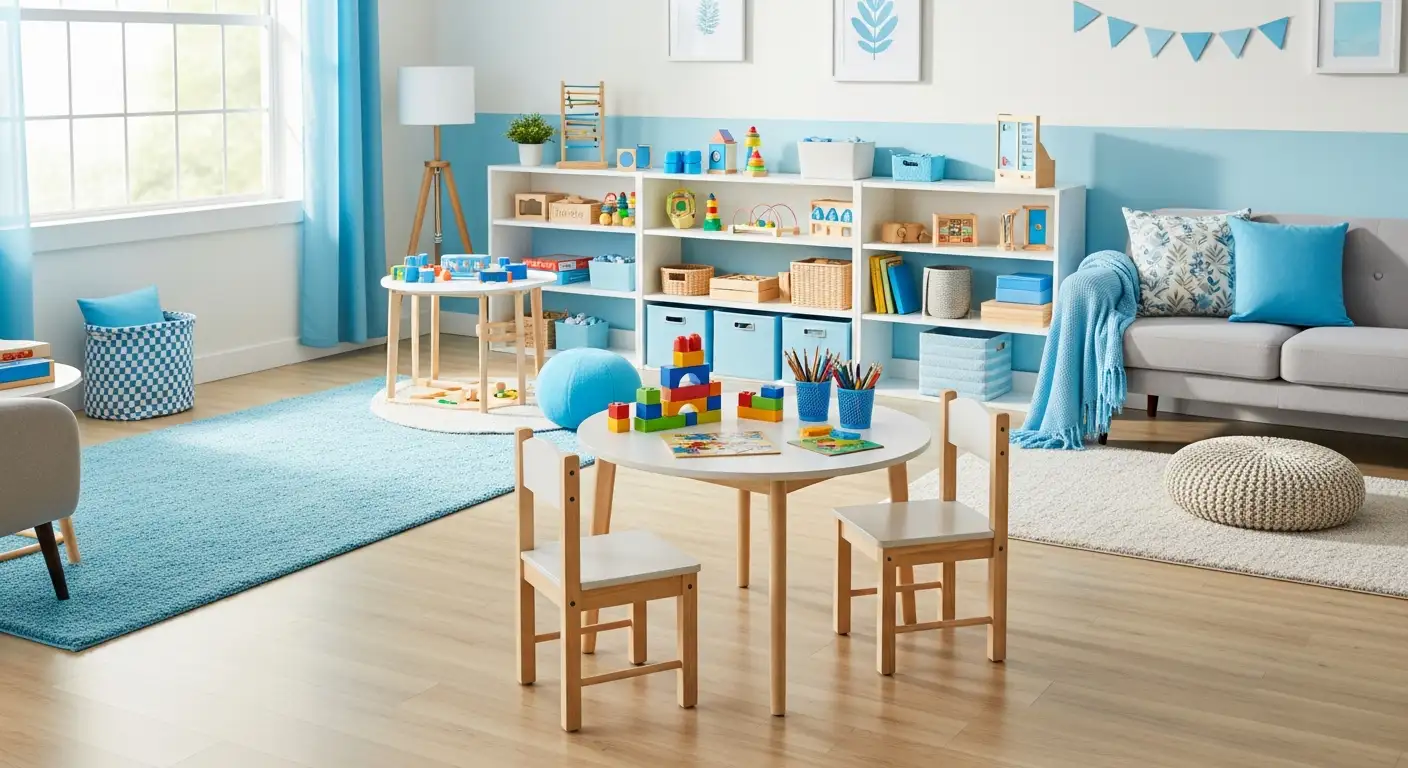
Understanding the Role of Play in ABA Therapy
Play serves as a vital context for early intervention in autism, fostering the development of essential social and communication skills. Applied Behavior Analysis (ABA) therapy utilizes this natural setting to promote peer engagement and improve social outcomes for children with autism spectrum disorder (ASD). This article explores how ABA therapy leverages play to increase peer interaction, the professionals involved, the diverse intervention methods, and how success is measured in these programs.
What Is Behavioral Analysis Therapy for Autism?
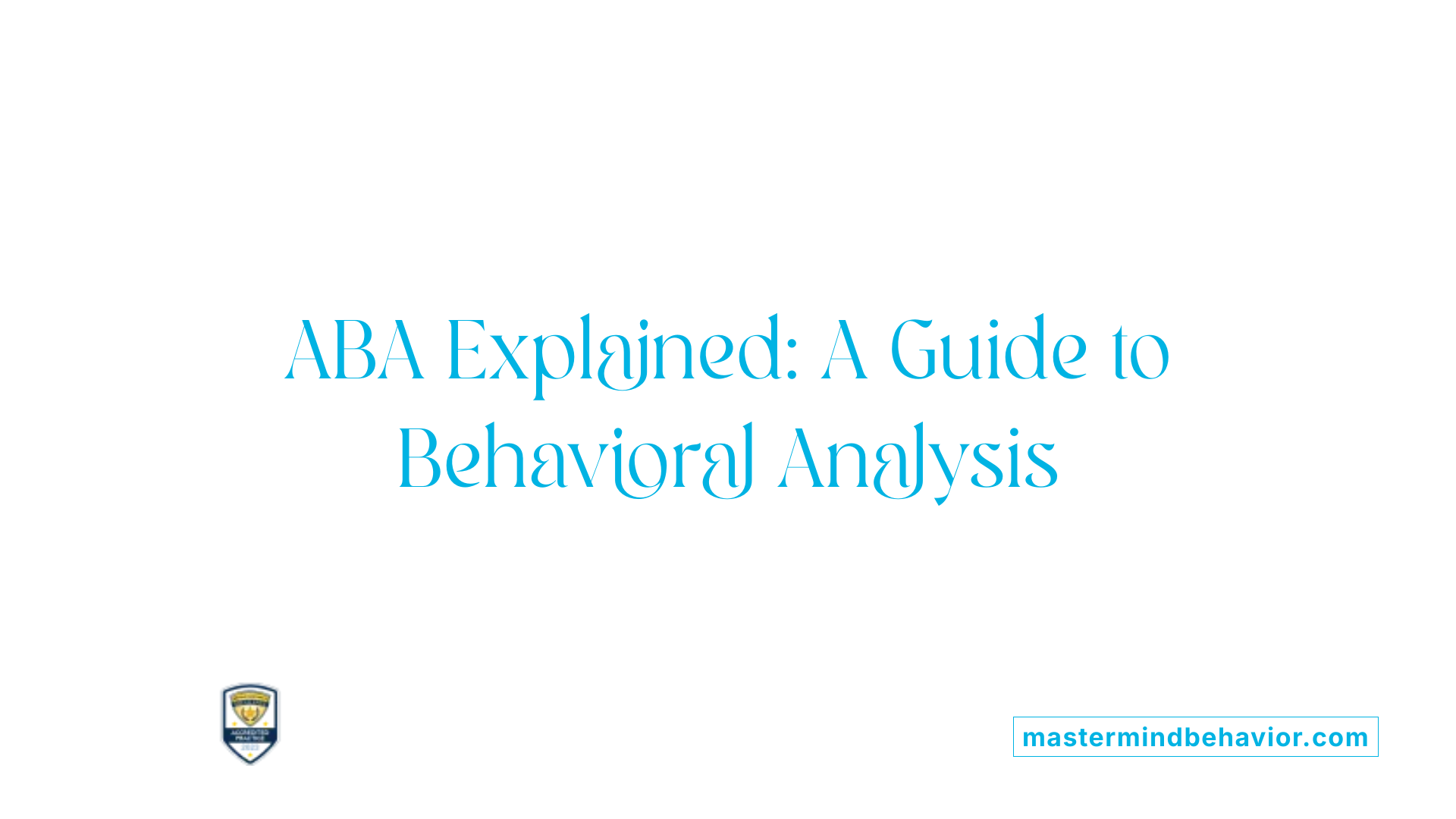
What is behavioral analysis therapy for autism?
Behavioral analysis therapy for autism, often referred to as Applied Behavior Analysis (ABA), is a science-driven method focused on improving specific behaviors and skills in individuals with autism. It operates on the principle that behaviors are influenced by environmental factors and seeks to encourage positive behaviors through targeted strategies.
Principles of ABA
ABA is grounded in the principles of learning theory, emphasizing how behaviors can be shaped by reinforcement and consequences. It typically employs techniques such as positive reinforcement, prompting, and task modeling to teach and strengthen communication, social interaction, and daily living skills.
Techniques used in ABA
Key techniques in ABA include:
- Positive reinforcement: Rewarding desired behaviors to increase their occurrence.
- Prompting: Providing cues or assistance to encourage correct responses.
- Skill modeling: Demonstrating behaviors for imitation.
Settings for delivering ABA therapy
ABA therapy is flexible and can be administered in various environments tailored to the child's needs, including home, school, or community settings. Treatment programs are individualized and often involve intensive, consistent intervention over time, supervised by qualified behavior analysts.
Evidence supporting ABA effectiveness
Extensive research supports ABA as an effective intervention for autism. Early and sustained ABA therapy has been linked to meaningful improvements in language development, cognitive function, social skills, and adaptive behaviors. While its effectiveness is well documented, ongoing studies continue to enhance ABA's techniques and assess long-term outcomes to refine therapy approaches further.
Who Provides ABA Therapy for Autism?

Types of professionals delivering ABA
Behavioral analysis therapy, or Applied Behavior Analysis (ABA), is typically provided by specialized professionals trained in behavior analysis. The primary providers are Board Certified Behavior Analysts (BCBAs), who have expertise in designing and supervising treatment plans tailored to each child's needs.
Licensed therapists and autism specialists also play a significant role in delivering ABA therapy sessions under the guidance of BCBAs. These can include speech therapists, occupational therapists, and psychologists who incorporate ABA principles into their interventions.
Role of Board Certified Behavior Analysts (BCBAs)
BCBAs are responsible for conducting assessments, developing individualized intervention strategies, overseeing implementation, and monitoring progress. Their expertise ensures that therapy is evidence-based and adapted to the child's social, communication, and behavioral goals.
Involvement of licensed therapists and autism specialists
Licensed therapists bring specialized skills to the therapy process, such as language development or sensory integration, which complement ABA techniques. Autism specialists may introduce play-based strategies that align with ABA principles to enhance social and communication skills.
Caregiver training and involvement
A critical part of ABA therapy involves training caregivers to support their child's development at home. Caregiver involvement helps generalize skills learned during therapy sessions and promotes consistency in behavior management.
Overall, ABA therapy is a collaborative and multidisciplinary effort, requiring coordinated input from BCBAs, therapists, specialists, and families to optimize outcomes for children with autism.
Goals of ABA Therapy for Autism
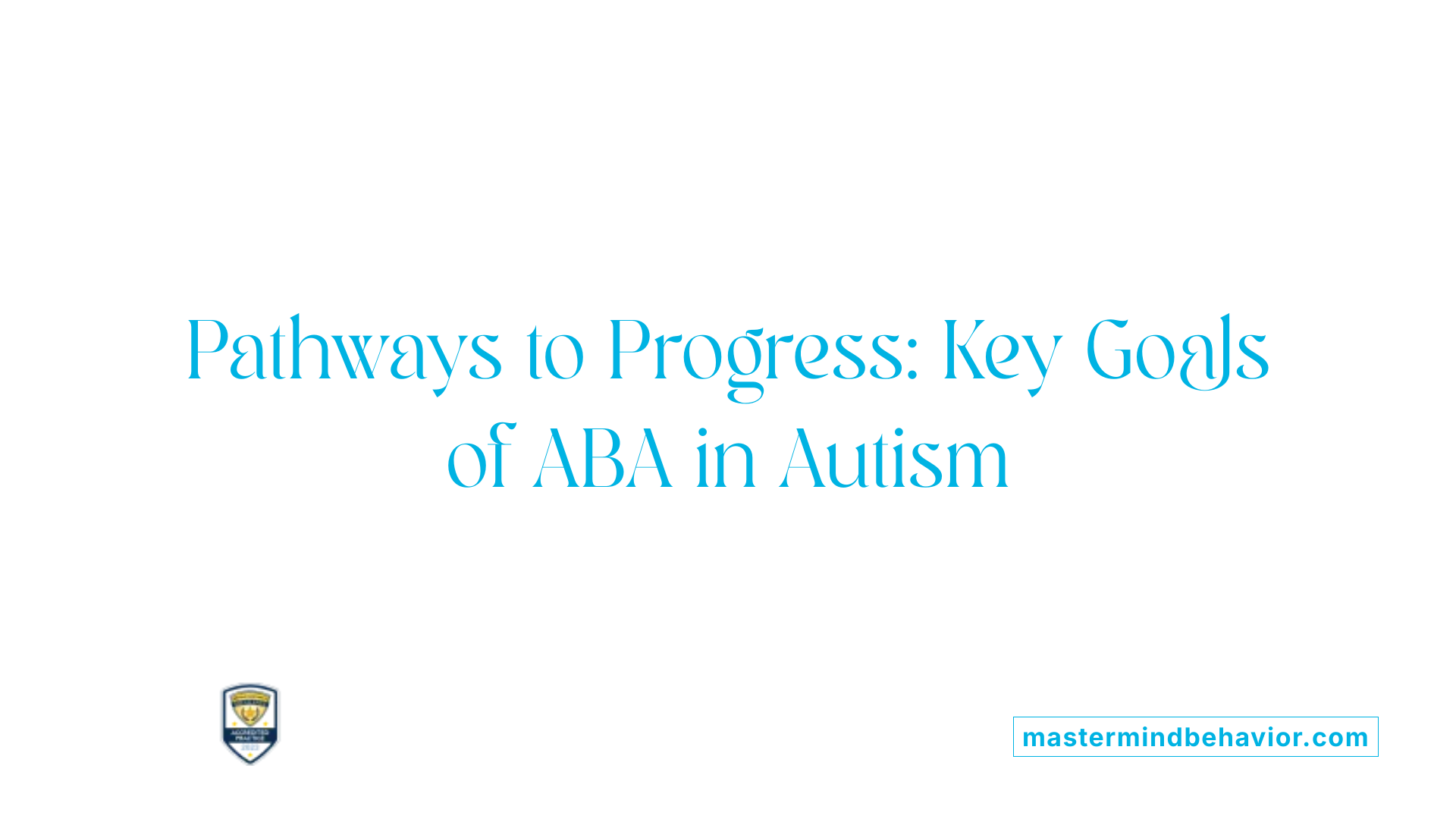
What are the goals of autism behavioral analysis therapy?
Applied Behavior Analysis (ABA) therapy aims to foster a range of adaptive behaviors that support individuals with autism in their daily lives. Primarily, ABA targets increasing helpful skills like communication, social interaction, self-care, and academic abilities. By focusing on these areas, ABA helps children learn to better navigate their environments and build meaningful relationships.
Improvement in communication and socialization is a central focus of ABA. Techniques within ABA support language development and enhance social skills, helping children to better express their needs and engage with others. This often involves teaching conversational skills, encouraging joint attention, and reinforcing positive social behaviors.
Another major goal is the reduction of challenging behaviors that may hinder learning or social interaction. ABA uses structured techniques such as positive reinforcement and discrete trial training to replace disruptive behaviors with more constructive ones, promoting smoother integration into school and community settings.
Early intervention is critical in ABA therapy. Programs are tailored to each child's unique needs with individualized planning that uses ongoing data collection to monitor progress and adjust strategies accordingly. Models like the Early Start Denver Model exemplify this personalized approach.
Ultimately, ABA therapy strives to promote independence and improve quality of life. By equipping children with communication skills, social competence, and self-care abilities, ABA empowers them to function more autonomously and confidently in various settings.
| Goals of ABA Therapy | Description | Typical Techniques |
|---|---|---|
| Increase adaptive behaviors | Enhance communication, social skills, self-care, academics | Positive reinforcement, pivotal response training |
| Improve communication and socialization | Develop language and social interaction skills | Joint attention training, social scripts |
| Reduce challenging behaviors | Decrease harmful, disruptive actions | Discrete trial training, behavior modification |
| Early intervention and individualization | Customize plans based on ongoing data | Early Start Denver Model, individualized goal setting |
| Promote independence and quality of life | Equip for autonomous functioning | Reinforcement strategies, life skills teaching |
Measuring the Effectiveness of ABA Therapy

How is the effectiveness of behavioral analysis therapy measured?
The effectiveness of Applied Behavior Analysis (ABA) therapy is measured by closely tracking an individual's progress in targeted behaviors over time. This involves systematic data collection and analysis to assess improvements in communication, social skills, adaptive behaviors, and reduction in challenging behaviors.
Standardized tools play a vital role in this process, with assessments designed to quantify changes accurately. Statistical methods, such as Multivariate Analysis of Covariance (MANCOVA), help determine the significance of behavioral improvements observed during therapy.
Evaluation often includes multiple outcome measures, reflecting the multifaceted goals of ABA interventions. These outcomes typically focus on enhanced language use, better social interactions, and increased independence.
Parental involvement is another important indicator of success. Active participation by caregivers in therapy and training sessions is associated with stronger generalization of skills beyond clinical settings, such as at home and school.
Finally, the generalization of skills across different environments confirms that gains are not limited to therapy sessions but translate into meaningful real-life improvements. This holistic approach ensures ABA therapy’s effectiveness is thoroughly and reliably measured.
The Importance of Play in Early Autism Intervention

Role of play in social and communication skill development
Play is widely recognized as a vital tool in early interventions for children with autism. It provides a natural and engaging context to foster social and communication skills, which are often areas of challenge for autistic children. Through play, children can practice turn-taking, joint attention, and expressive language in an enjoyable and meaningful way, facilitating skill acquisition that extends beyond therapy sessions.
Why play is used as a context for intervention
Interventions use play as a context because it creates a motivating and flexible environment tailored to individual children's interests and developmental levels. This helps make learning social interaction more accessible and less intimidating for children with autism. Play also serves as a framework to incorporate various therapeutic approaches—from behavioral to developmental—helping target different components of social and communicative behavior effectively.
Developmental benefits of using play-based approaches
Play-based interventions support multiple developmental domains by combining behavioral reinforcement with naturalistic interaction styles. These approaches enhance not only language and communication but also social play skills, emotional expression, and problem-solving abilities. The diversity of methods, such as parent training, joint attention techniques, and even emerging robot-assisted play, highlights the adaptability and depth of these interventions.
Age range commonly targeted in play-based interventions
Most play-based interventions focus on children aged 2 to 8 years. This range is crucial as it corresponds with early childhood, a time when social and communication skills rapidly develop. Targeting interventions during this period can maximize the developmental gains and set a strong foundation for future learning and social functioning.
Types of Play-Based Interventions in Autism ABA Therapy
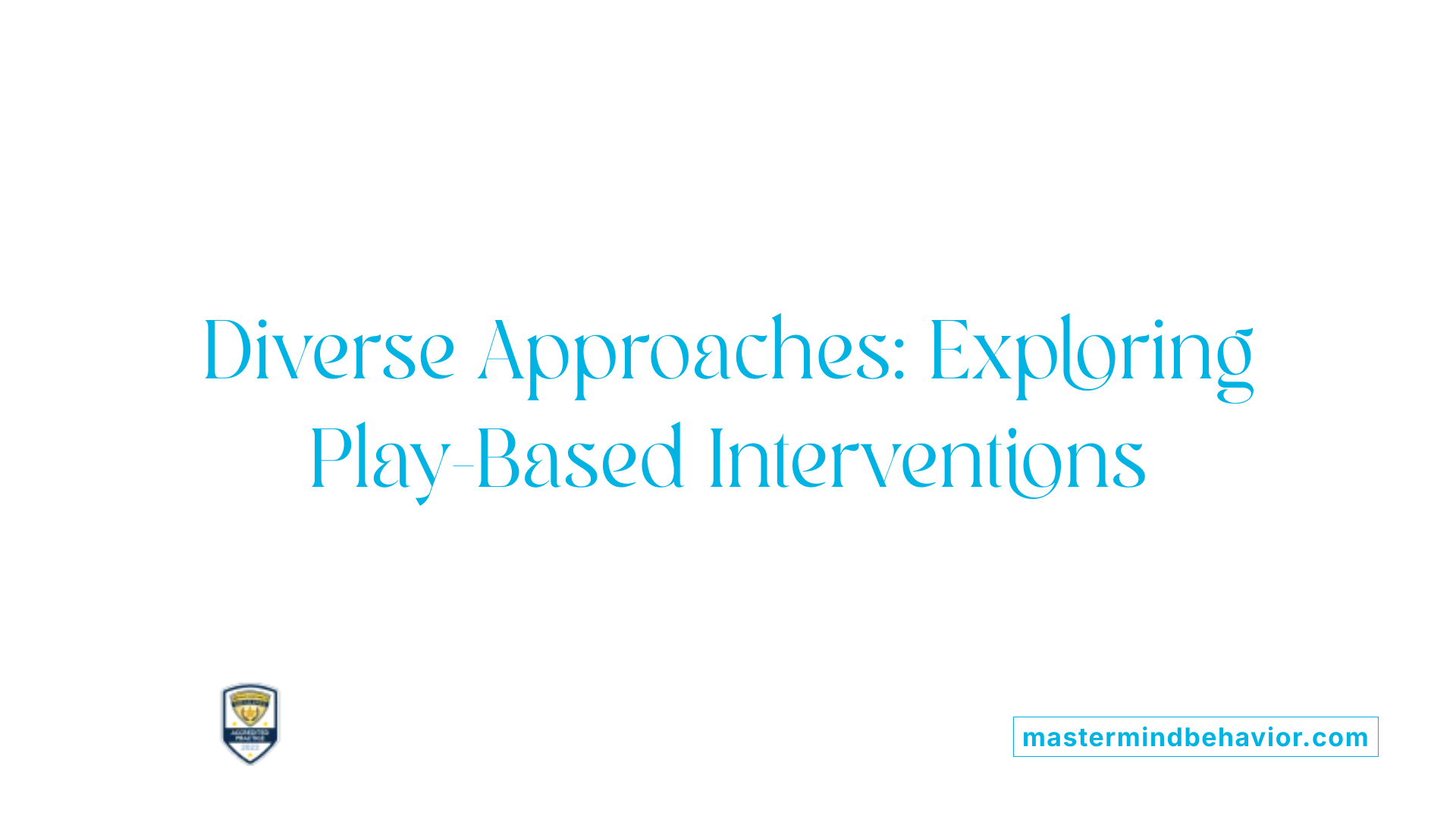
What Are Behavioral, Developmental, and Interdisciplinary Approaches?
Play-based interventions incorporate diverse methods tailored to specific aspects of play. Behavioral approaches often use feedback and reinforcement to encourage desired social behaviors. Developmental strategies focus on nurturing natural interaction skills aligned with a child’s developmental stage. Interdisciplinary methods combine expertise from multiple fields—including psychology, speech therapy, and occupational therapy—to address the complex needs of children on the autism spectrum.
How Is Play Used in These Interventions?
Play is utilized variably—as a context for learning, a component of therapy sessions, or the mechanism driving development. Using play as a context means embedding intervention goals within natural play activities. When used as a component, specific play skills are targeted directly. Play as a key mechanism involves harnessing play's motivational qualities to promote social communication and engagement.
What Are Social Skills Groups and Parent Training Programs?
Social skills groups focus on improving peer interaction through guided play scenarios, helping children practice communication in group settings. Parent training programs empower caregivers with strategies to facilitate play that enhances social and language skills at home, ensuring consistency and reinforcement beyond clinical settings.
How Do Joint Attention Techniques Like JASPER Work?
Techniques such as JASPER (Joint Attention, Symbolic Play, Engagement, and Regulation) emphasize shared focus between the child and therapist or caregiver. This approach enhances foundational communication by encouraging children to coordinate attention and engage meaningfully during play, which supports broader language and social development.
What Are Innovative Methods Like LEGO Therapy and Robot-Assisted Play?
LEGO therapy uses structured building activities to promote cooperation, communication, and turn-taking among children. Robot-assisted play introduces interactive robots to attract engagement and facilitate social interactions in a controlled, motivating environment. These innovative methods expand the tools available to therapists and educators to customize intervention to individual interests and needs.
Customizing ABA Interventions to Foster Peer Engagement During Play

Tailoring ABA Strategies to Individual Needs
Applied Behavior Analysis (ABA) interventions are most effective when customized to the unique preferences, abilities, and challenges of each child with autism. By assessing each child's specific social and communication skills, practitioners can design play activities that both motivate and support skill acquisition.
Incorporating Social Play Goals
ABA plans often emphasize social play objectives such as initiating interactions, sharing toys, and taking turns. Embedding these goals within fun, meaningful play contexts helps children practice and generalize social skills naturally.
Use of Positive Reinforcement and Prompting in Play Scenarios
Positive reinforcement—such as praise or preferred items—is used to encourage desired behaviors during play. Prompting, whether verbal, gestural, or physical, guides children toward successful social exchanges. Gradually, prompts are faded to foster independence.
Engaging Peers and Siblings in Structured Play
Including peers and siblings in structured ABA play sessions expands social opportunities. This involvement encourages reciprocal communication and helps children with autism learn appropriate social responses in familiar, supportive environments.
Building Communication Through Joint Play Activities
Joint play activities serve as a natural platform to develop language and communication skills. ABA providers incorporate shared interests, such as favorite toys or games, to prompt requests, comments, and collaborative problem-solving.
Structured, play-based ABA interventions combining these elements create a dynamic and supportive environment fostering peer engagement and communication growth.
Role of Multidisciplinary Teams in ABA Play Interventions

What roles do psychologists, speech therapists, and occupational therapists play in ABA play interventions?
Psychologists contribute by assessing cognitive and behavioral aspects, designing tailored intervention strategies. Speech therapists focus on enhancing communication skills through targeted play activities. Occupational therapists support sensory integration and fine motor skills, facilitating engagement in play.
How do educators and behavior analysts collaborate in these interventions?
Educators bring insight into learning styles and school environments, applying ABA principles in educational settings. Behavior analysts develop data-driven approaches to modify behaviors during play, ensuring consistent skill acquisition and reinforcement.
How is developmental and behavioral expertise integrated in multidisciplinary teams?
Teams blend developmental understanding—recognizing age-appropriate play behaviors—and behavioral methods focusing on reinforcement and acquisition of social skills, enabling comprehensive support that adapts to each child's progress.
How do these teams support holistic treatment plans for social play skills?
By combining their distinct expertise, multidisciplinary teams create individualized, multifaceted interventions that address social, communication, and sensory needs. This holistic care improves the effectiveness of play-based strategies and maximizes developmental outcomes for children with autism.
Challenges in Implementing Play-Based ABA Therapy for Peer Engagement

Balancing Structured and Naturalistic Play
Play-based ABA interventions for children with autism often navigate the balance between structured activities and natural play contexts. While structured play provides clear goals and consistent feedback, naturalistic play encourages spontaneity and social interaction. Therapists must carefully blend these approaches to promote meaningful peer engagement without stifling creativity or flexibility.
Addressing Varying Sensory Needs During Play
Children with autism frequently exhibit diverse sensory sensitivities that can impact their play experiences. Play-based interventions require tailored strategies to accommodate these needs, such as adjusting play environments or selecting sensory-appropriate toys. Effectively managing sensory preferences helps maintain focus and participation, which are crucial for fostering peer interaction.
Engaging Non-Autistic Peers Effectively
Peer engagement relies not only on the child with autism but also on their non-autistic peers. Successfully involving neurotypical children in play requires preparation and training to promote understanding, patience, and supportive behaviors. Interventions may incorporate social skills groups or parent training programs to facilitate this inclusive dynamic.
Sustaining Motivation and Interest
Motivation can fluctuate during therapy, especially for young children. Maintaining interest in play-based activities entails offering age-appropriate, diverse, and intrinsically motivating tasks. Employing elements such as LEGO® therapy or robot-assisted play can introduce novelty and enjoyment, thereby enhancing sustained participation and social interaction.
Ensuring Generalization Outside Therapy Settings
A critical challenge is transferring skills learned during therapy to natural settings, such as homes or schools. Multidisciplinary approaches involving psychologists, speech therapists, occupational therapists, and educators support the reinforcement of social and communication skills across environments. Consistent practice and collaboration among caregivers and peers further encourage this generalization.
Overview Table of Challenges and Strategies
| Challenge | Description | Strategies |
|---|---|---|
| Structured vs. Naturalistic Play | Balancing clear guidance with spontaneous interaction | Blending feedback-based and developmental methods |
| Sensory Needs | Managing sensitivities that affect play participation | Sensory-friendly environments and adaptive toys |
| Engaging Peers | Involving neurotypical children as supportive playmates | Social skills groups, parent training |
| Motivation | Keeping children interested in activities | Using engaging tools like LEGO® therapy, robots |
| Generalization | Applying skills beyond therapy | Multidisciplinary collaboration and consistent practice |
Evidence Supporting Play-Based ABA Interventions
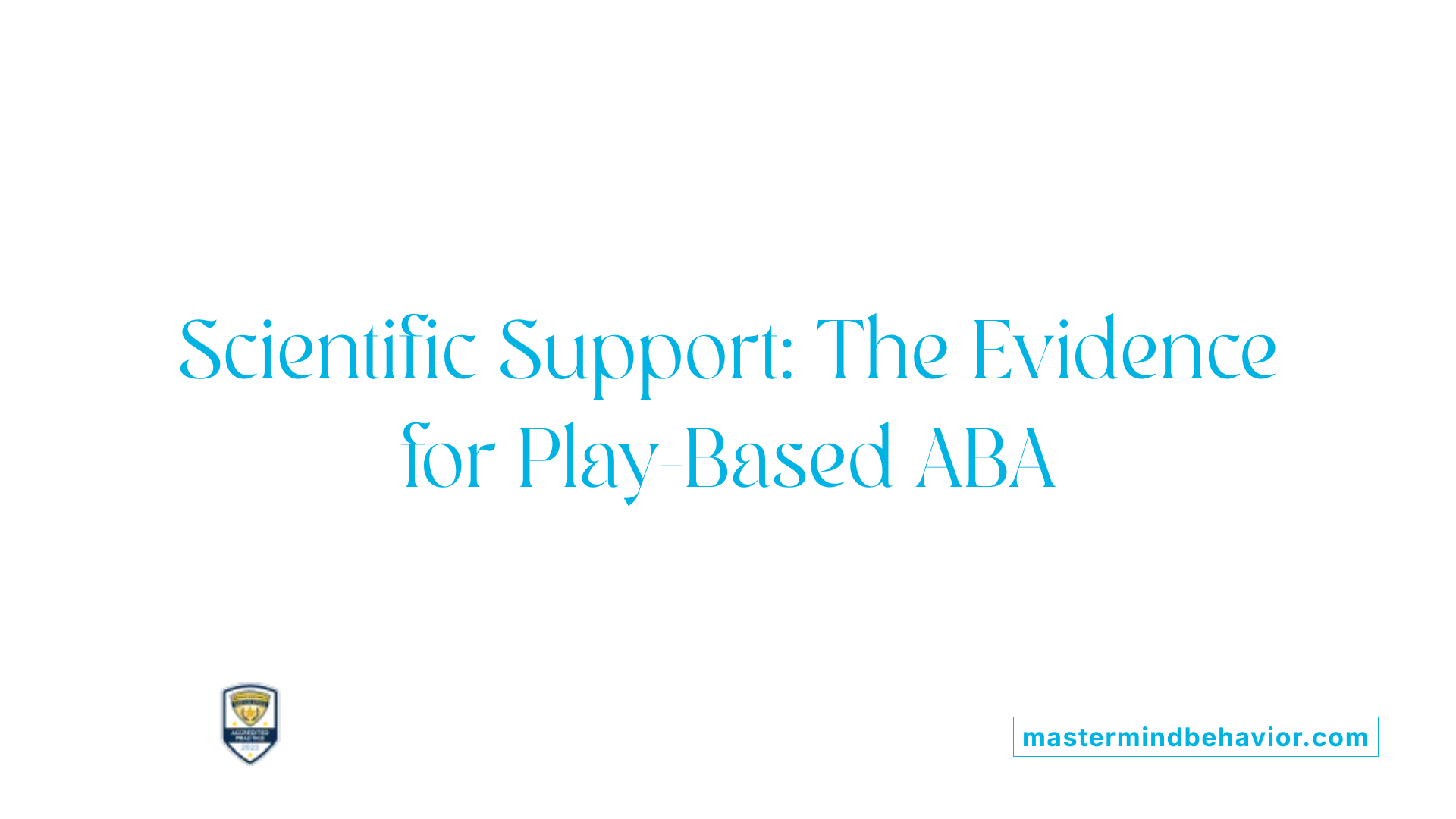
What does research say about randomized controlled trials on play interventions?
Play-based interventions for children with autism often include randomized controlled trials (RCTs), which make up about 21% of the study designs. These trials offer robust evidence supporting the effectiveness of such interventions. RCTs typically explore diverse play methods like joint attention approaches (e.g., JASPER), LEGO therapy, and robot-assisted play.
How do social and communication skills benefit from these interventions?
The majority of studies focus on improvements in social and communication skills as primary outcomes. Play serves as both a medium and mechanism to encourage interaction and language development. Gains include enhanced social play abilities, better joint attention, and increased communicative exchanges.
What are the strengths and limitations of current research?
Strengths include the multidisciplinary involvement of psychologists, speech therapists, occupational therapists, and educators, which ensures comprehensive intervention delivery. However, limitations include variable study designs and a relatively small number of rigorous RCTs, indicating the need for further high-quality research.
Are there trends regarding efficacy related to age and intervention types?
Most interventions target young children aged 2 to 8 years, where developmental plasticity supports skill acquisition. Effectiveness can vary based on the type of intervention—behavioral, developmental, or interdisciplinary—with combined approaches often showing promise.
| Aspect | Details | Notes |
|---|---|---|
| Study Designs | Variety including ~21% RCTs | RCTs provide stronger evidence |
| Target Age Range | 2-8 years | Optimal for early developmental support |
| Intervention Approaches | Behavioral, developmental, interdisciplinary methods | Tailored to intervention goals |
| Multidisciplinary Roles | Psychologists, speech therapists, occupational therapists, educators | Enhances scope and effectiveness |
| Outcome Measures | Social play, communication skills | Frequently report multiple relevant outcomes |
Parental and Caregiver Roles in Promoting Social Play Skills

How Are Parents Trained in ABA Techniques?
Parental training in Applied Behavior Analysis (ABA) techniques is a cornerstone of many play-based interventions for children with autism. These programs often include teaching parents how to observe their child’s behavior, apply positive reinforcement, and use prompting strategies during play activities. This training empowers parents to create supportive play environments that encourage social interaction and communication development.
How Can Social Behaviors Be Reinforced During Daily Routines?
Reinforcement of social behaviors is most effective when integrated into daily routines outside therapy sessions. Parents and caregivers incorporate structured play moments throughout the day—such as during mealtime, dressing, or bath time—providing immediate and consistent positive feedback when the child initiates or responds socially. This ongoing reinforcement helps generalize social skills beyond clinical settings.
In What Ways Can Parents Support Peer Interaction Outside Therapy?
Supporting peer interactions is vital for building social competence. Parents can facilitate opportunities for their children to play with siblings, neighborhood children, or playmates in safe and guided environments. They may organize playdates or participate in social skills groups that enable children to practice turn-taking, joint attention, and cooperative play under adult supervision.
How Do Parents Build Communication and Play Facilitation Skills at Home?
Parents enhance their child’s communication and play skills by learning facilitation methods such as modeling appropriate play behavior, using simple language prompts, and incorporating the child’s interests to motivate engagement. Training often involves interdisciplinary professionals guiding parents in tailored strategies, helping to make play a natural context for language and social development at home.
Integrating Technology in Play-Based ABA Therapy

How is robot-assisted play used in autism interventions?
Robot-assisted play is an innovative approach within play-based interventions for children with autism. Robots can serve as engaging, predictable partners that facilitate social interaction and communication. These tools often help children practice joint attention, turn-taking, and other social play skills in a fun and interactive way. By integrating robots, therapists can create structured yet motivating contexts for learning, accommodating individual needs.
How are digital tools incorporated to support engagement?
Digital tools like apps, interactive games, and virtual environments extend play-based therapy by providing varied platforms that capture children's interest. These tools allow customization based on developmental levels and learning goals, increasing motivation and active participation. Often combined with traditional ABA methods, such digital media support language development and social skills through interactive scenarios and immediate feedback.
What are the benefits and drawbacks of technology-based play?
Benefits include increased engagement, consistency in delivering interventions, and the ability to collect data automatically for monitoring progress. They offer appealing and repeatable play scenarios that can be adjusted easily. However, drawbacks involve potential over-reliance on screens, which might reduce spontaneous social interactions, and the need for specialized training for therapists and caregivers to use technology effectively.
What are future directions for tech integration in ABA?
The future involves developing more sophisticated, adaptable technologies that personalize interventions in real time. Incorporating artificial intelligence and enhanced robotics could provide more naturalistic social cues and dynamic interaction opportunities. Moreover, expanding access and ease of use at home and school settings will help broaden the reach of play-based ABA therapies incorporating technology, enhancing outcomes for children with autism.
Measuring Progress in Peer Engagement During Play
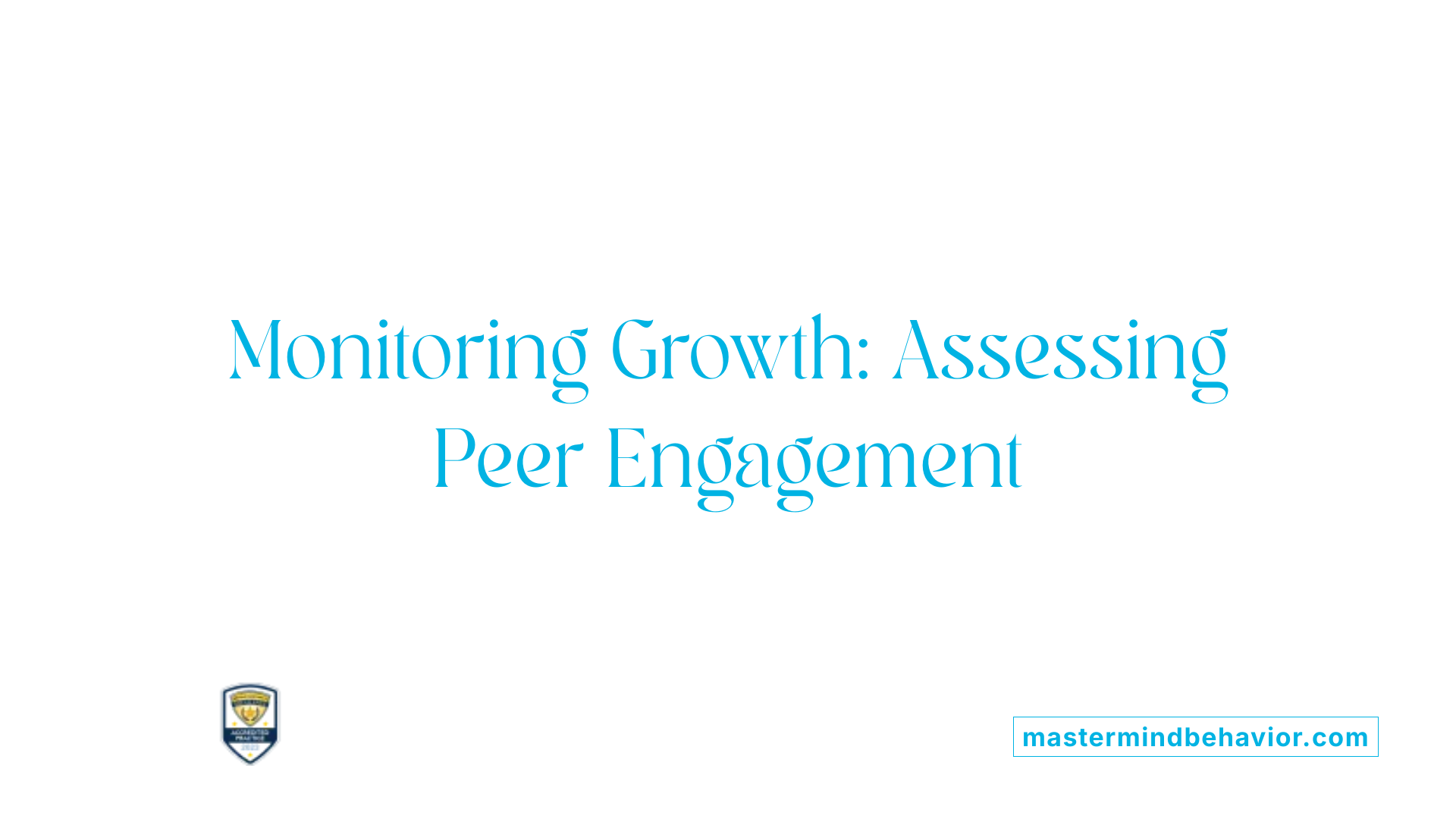
What Assessment Tools Are Used for Social Play Skills?
Assessing social play skills in children with autism often involves standardized tools and tailored checklists that focus on interaction quality, initiation of play, and communication. Tools like the Social Skills Improvement System (SSIS) and the Autism Diagnostic Observation Schedule (ADOS) help quantify progress in social engagement during play settings.
What Are Behavioral Markers of Increased Peer Interaction?
Behavioral markers include more frequent eye contact, turn-taking, shared attention to play objects, and spontaneous communication efforts. Improved imitation skills and cooperative play behaviors are also strong indicators of enhanced peer engagement.
How Are Direct Observation and Video Analysis Used?
Direct observation allows therapists and educators to monitor real-time social interactions, providing immediate feedback and adjustments in interventions. Video analysis supports detailed review of play sessions, capturing subtle behaviors and patterns not always evident during live sessions.
Why Is Longitudinal Tracking Important?
Long-term tracking measures the sustainability and generalization of social skills gains. It helps evaluate whether improvements in peer engagement during play persist and translate into broader social contexts over time, guiding adjustments in intervention strategies.
Social Play as a Key Mechanism in Skill Development
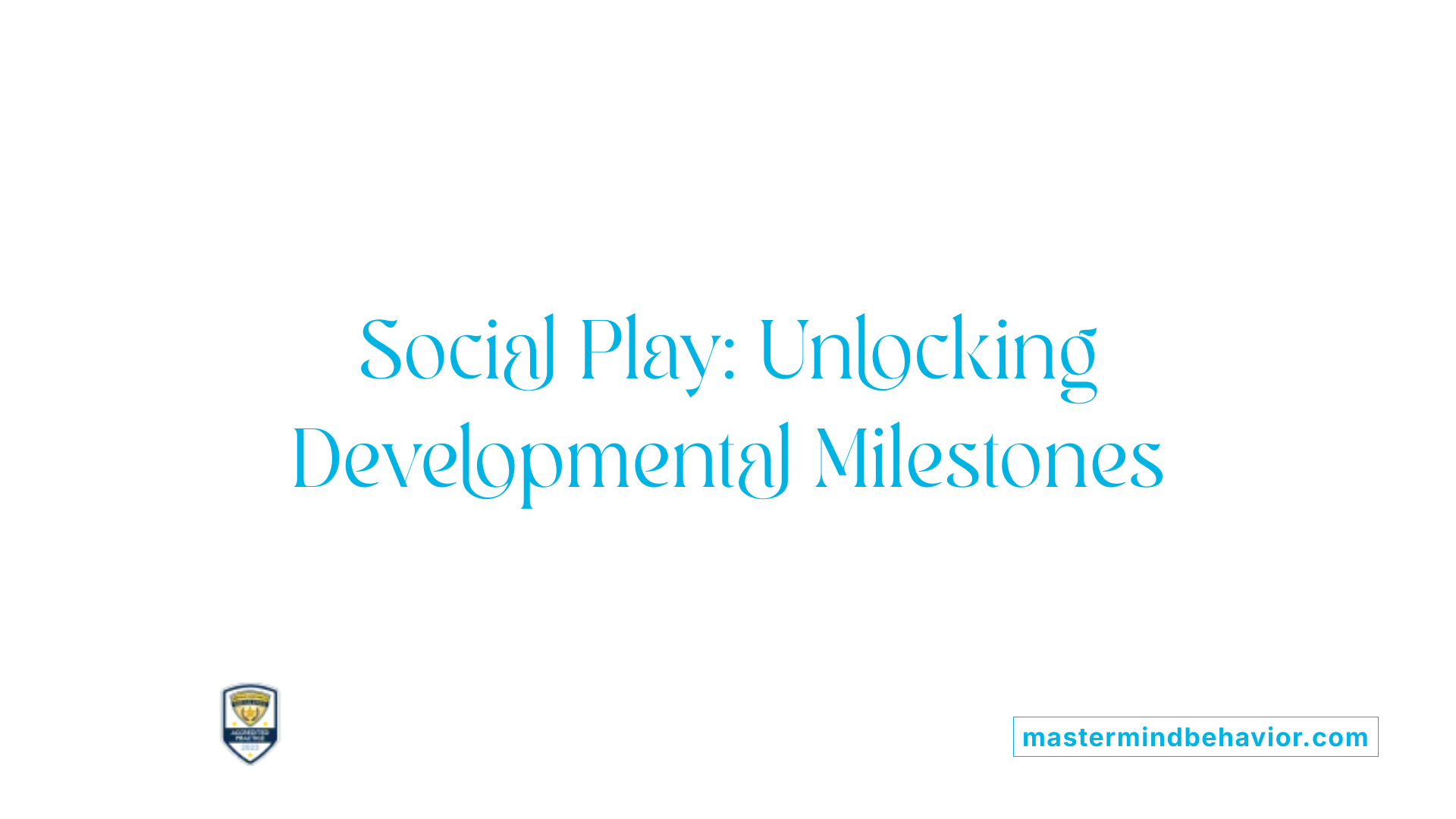
How social play supports communication growth
Social play serves as a natural environment where children with autism can develop vital communication skills. Through interactive play, children practice using language in meaningful contexts, expanding their ability to express needs, thoughts, and emotions effectively. Play creates opportunities for children to engage in dynamic exchanges that foster vocabulary building and pragmatic language use.
Relationship between play and joint attention
Joint attention, the shared focus between a child and another person on an object or activity, is central to many play-based interventions. Techniques like JASPER (Joint Attention, Symbolic Play, Engagement, and Regulation) emphasize using play to improve a child’s ability to coordinate attention with others. Enhancing joint attention during play supports better social engagement and learning.
Developing conversational turn-taking skills
Play-based activities provide a natural platform for practicing conversational turn-taking. Interactive games and pretend scenarios encourage children to wait their turn, respond appropriately, and maintain back-and-forth communication. These interactions are instrumental in cultivating fundamental social communication skills necessary for effective conversations.
Peer play's role in emotional and social learning
Playing alongside peers offers children with autism opportunities to explore emotions, interpret social cues, and develop empathy. Through group play, children learn cooperation, sharing, and conflict resolution, which are essential for emotional regulation and social competence. Peer interactions during play thus contribute significantly to holistic social skill development.
Applying Feedback-Based Approaches in Play Scenarios

Using real-time feedback to shape play behaviors
Feedback-based approaches leverage immediate responses to guide and enhance children's play interactions. When a child engages in a play behavior, therapists or educators provide instant feedback, helping to reinforce positive actions or gently redirect less constructive behaviors. This real-time input is crucial for fostering understanding and encouraging adaptive social play.
Positive reinforcement during peer interactions
Positive reinforcement is a cornerstone of feedback-based methods. During peer interactions, children receive affirmations such as praise, smiles, or tangible rewards when they demonstrate desired social and communication skills. This reinforcement encourages the repetition of these behaviors, promoting more meaningful and sustained social engagement.
Adjusting prompts based on response
Practitioners closely monitor how children respond to various prompts during play. Depending on a child's reaction, prompts are dynamically adjusted—whether they need to be more supportive or gradually faded—to optimize learning without causing frustration. This tailored prompting helps improve play competence and communication effectiveness.
Encouraging independent play skills
While immediate feedback supports guided play, encouraging independent play skills remains a critical goal. Over time, feedback-based interventions aim to reduce prompts and reinforcement, empowering children to initiate and maintain play activities autonomously. This progression supports their growing confidence and social competence in everyday settings.
Developmental and Behavioral Methods in Play Interventions

Combining Behavioral and Developmental Strategies
Play-based interventions for children with autism spectrum disorder (ASD) frequently integrate both behavioral and developmental approaches. This blend helps tailor play activities that not only teach new skills but also support natural development trajectories, creating a supportive environment for learning social and communication skills through interactive play.
Pivotal Response Treatment and Early Start Denver Model
Two well-known developmental behavioral interventions are Pivotal Response Treatment (PRT) and the Early Start Denver Model (ESDM). PRT focuses on improving pivotal areas such as motivation and response to multiple cues using play as a natural context for learning. Meanwhile, ESDM combines applied behavioral analysis with developmental science, emphasizing early intervention and structured play that fosters social engagement.
Progressive Skill Building During Play
These interventions emphasize progressive skill development, where complex abilities are broken down into manageable components and taught step-by-step during play sessions. This gradual technique allows children to build on prior skills, reinforcing learning through repetition and positive reinforcement within a playful context.
Role of Naturalistic Developmental Behavioral Interventions
Naturalistic Developmental Behavioral Interventions (NDBIs) represent a category that merges behavioral techniques with developmental principles in everyday play settings. They focus on leveraging children's interests and motivation during play to encourage communication, social interaction, and flexible thinking, making learning engaging and personalized.
Through these methods, therapists and educators create dynamic, responsive play environments that not only enhance social and communication skills but also adapt to each child's individual developmental needs.
The Impact of Early Start Denver Model within Play ABA Therapy

Principles of the Early Start Denver Model (ESDM)
The Early Start Denver Model (ESDM) is a play-based intervention designed specifically for young children with autism, typically between the ages of 2 and 8. It integrates behavioral and developmental approaches, focusing on using natural play as the context for learning. The model emphasizes building social communication and play skills by embedding teaching moments within enjoyable, child-led activities.
Using play to teach communication and social skills
In ESDM, play is more than just fun; it serves as a fundamental teaching tool. Therapists and caregivers engage children through meaningful play scenarios, promoting joint attention, imitation, and reciprocal interaction. These play activities stimulate language development and social engagement, helping children acquire foundational skills for interacting with peers and adults.
Evidence of ESDM effectiveness in peer engagement
Research on ESDM shows promising results in improving social communication and peer interactions. Many studies include randomized controlled trials demonstrating increases in eye contact, vocalizations, and shared enjoyment during play sessions. Notably, this intervention fosters enhanced peer engagement by encouraging children to initiate and respond within social play contexts.
Integration with broader ABA programming
While ESDM is distinct in its developmental and play-based focus, it often integrates seamlessly with broader Applied Behavior Analysis (ABA) programming. This multidisciplinary approach can involve psychologists, speech therapists, and educators working together to tailor goals and strategies, enhancing the overall impact on social and communication outcomes.
| Aspect | Description | Role in ESDM |
|---|---|---|
| Age Range | Typically 2-8 years old | Target population for intervention |
| Intervention Focus | Social communication, play skills | Core learning domains |
| Play Use | Context for teaching, reinforcing communication | Primary mechanism of learning |
| Evidence | Includes randomized controlled trials | Supports effectiveness in social engagement |
| Professional Involvement | Psychologists, speech therapists, educators | Multidisciplinary delivery of therapy |
Promoting Joint Attention to Enhance Peer Interaction
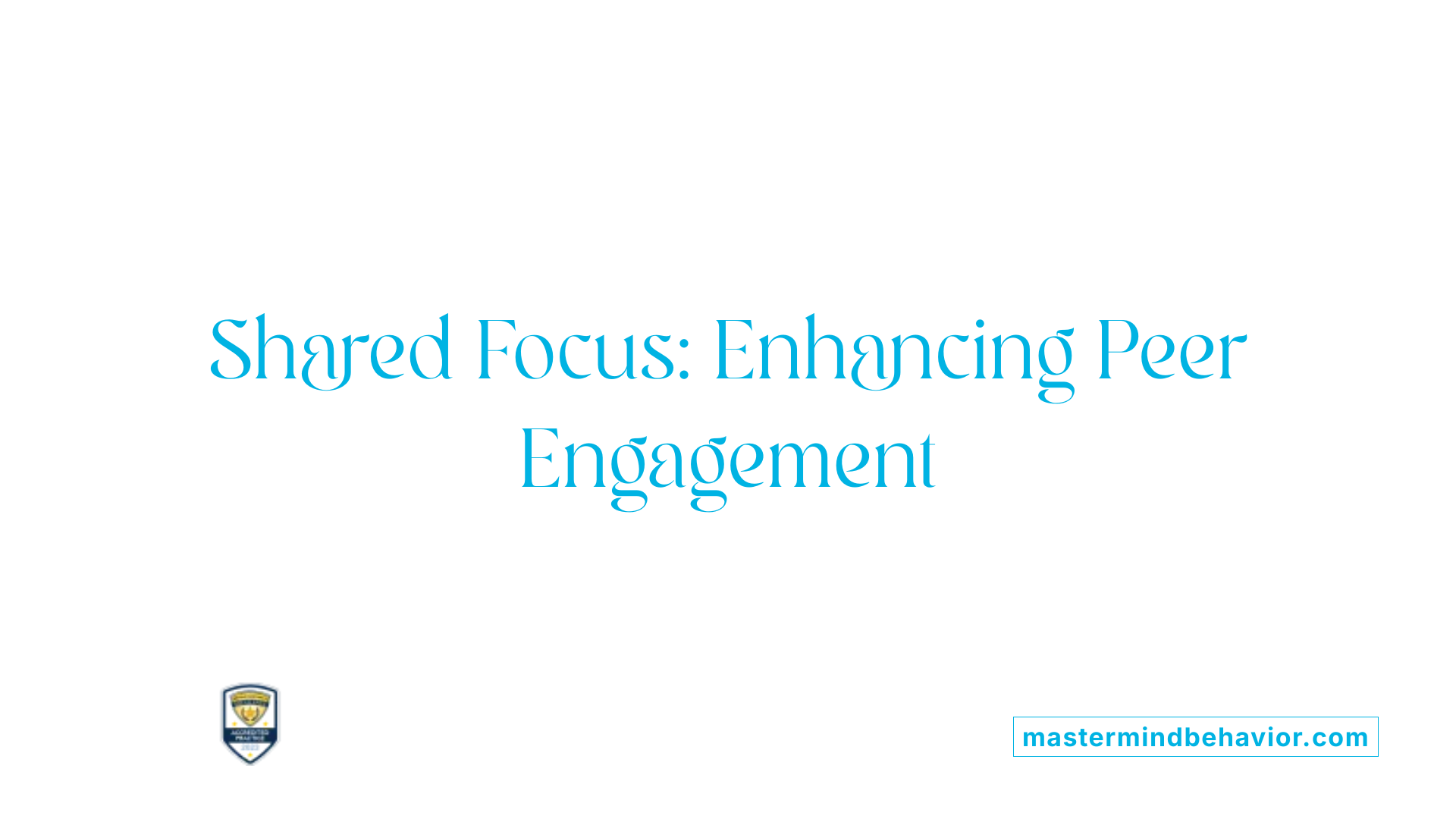
Why is joint attention important in autism therapy?
Joint attention—the ability to share focus on an object or event with another person—is fundamental for social and communicative development in children with autism. Difficulties with joint attention often contribute to challenges in peer interaction and language acquisition. As a result, fostering joint attention is a priority in autism interventions designed to improve social engagement and communication skills.
How do techniques like JASPER improve joint engagement?
JASPER (Joint Attention, Symbolic Play, Engagement, and Regulation) is a structured, play-based intervention that targets joint attention and symbolic play skills. It uses naturalistic strategies, such as following the child's lead and incorporating their interests, to encourage sustained shared attention. Through repetitive and responsive play activities, JASPER helps children practice initiating and responding to joint attention cues, which enhances their ability to engage meaningfully with peers.
What role does joint attention play in social and communicative development?
Joint attention forms the foundation for learning social cues, turn-taking, and communication. By improving joint attention, children with autism gain skills that support language development, social reciprocity, and the understanding of others' perspectives. Strengthening this ability through play creates a more interactive and supportive environment for social learning.
How does improved joint attention impact play-based learning opportunities?
Enhanced joint attention opens up richer play experiences where children can participate in shared games and collaborative problem-solving. This improvement allows play to serve as a dynamic context for practicing communication and social skills. Interventions targeting joint attention promote not only immediate engagement but also long-term social competence through play-based learning.
Role of LEGO Therapy in Facilitating Social Skills
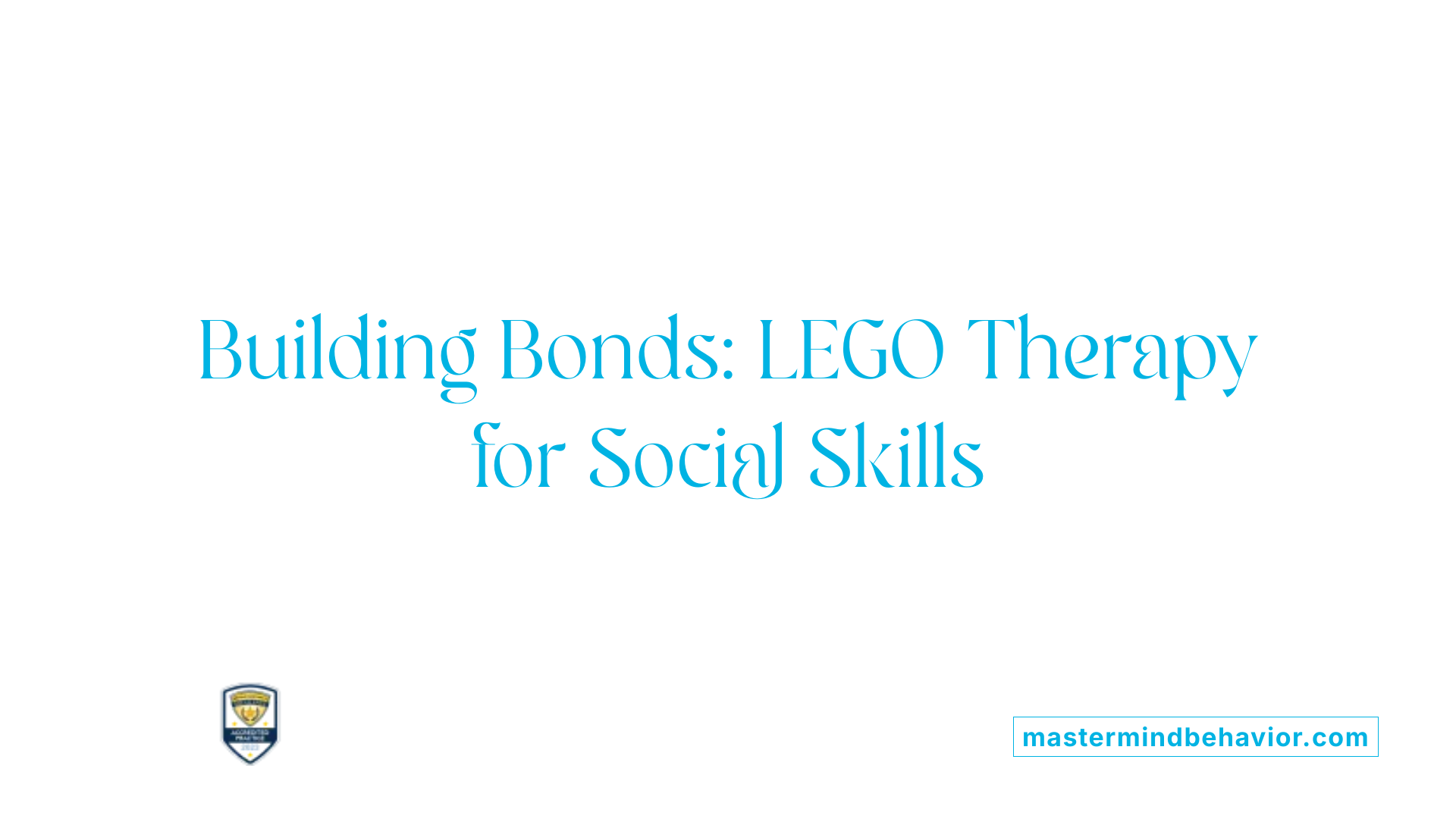
How LEGO therapy encourages turn-taking and collaboration
LEGO therapy is designed as a structured play intervention where children work together to build LEGO projects. This setup naturally encourages turn-taking because participants must share pieces, follow building instructions, and negotiate roles within the activity. Collaboration becomes essential as children rely on each other to complete the project, fostering teamwork.
Benefits for peer engagement and communication
Through shared goals, LEGO therapy boosts peer engagement by creating meaningful opportunities for social interaction. It promotes verbal and nonverbal communication, helping children practice expressing ideas, listening, and responding to peers. These social exchanges help improve overall communication skills in a supportive environment.
Structured play as a therapeutic medium
The predictability and organization of LEGO play provide a clear framework within which children can safely explore social behaviors. The structured nature helps reduce anxiety around social situations and allows therapists to guide interventions more effectively, targeting specific social skills.
Evidence supporting effectiveness in ASD
Research indicates that LEGO therapy positively impacts social and communication outcomes in children with autism spectrum disorder (ASD). Studies have documented improvements in social play and cooperative interactions, suggesting its value as part of multidisciplinary intervention programs aimed at children aged 2-8 years.
| Aspect | Role in LEGO Therapy | Description |
|---|---|---|
| Turn-taking | Encouraged through shared building tasks | Children alternate actions and share pieces, learning patience |
| Collaboration | Essential for project completion | Promotes teamwork, problem-solving, and mutual support |
| Peer engagement | Facilitated by shared goals | Increases social interaction and communication opportunities |
| Structured therapeutic play | Provides a clear framework | Helps children practice social skills in a predictable setting |
| Evidence base | Supported by research in ASD interventions | Shows improvements in social and communication abilities |
Implementing Social Skills Groups to Boost Play Interaction
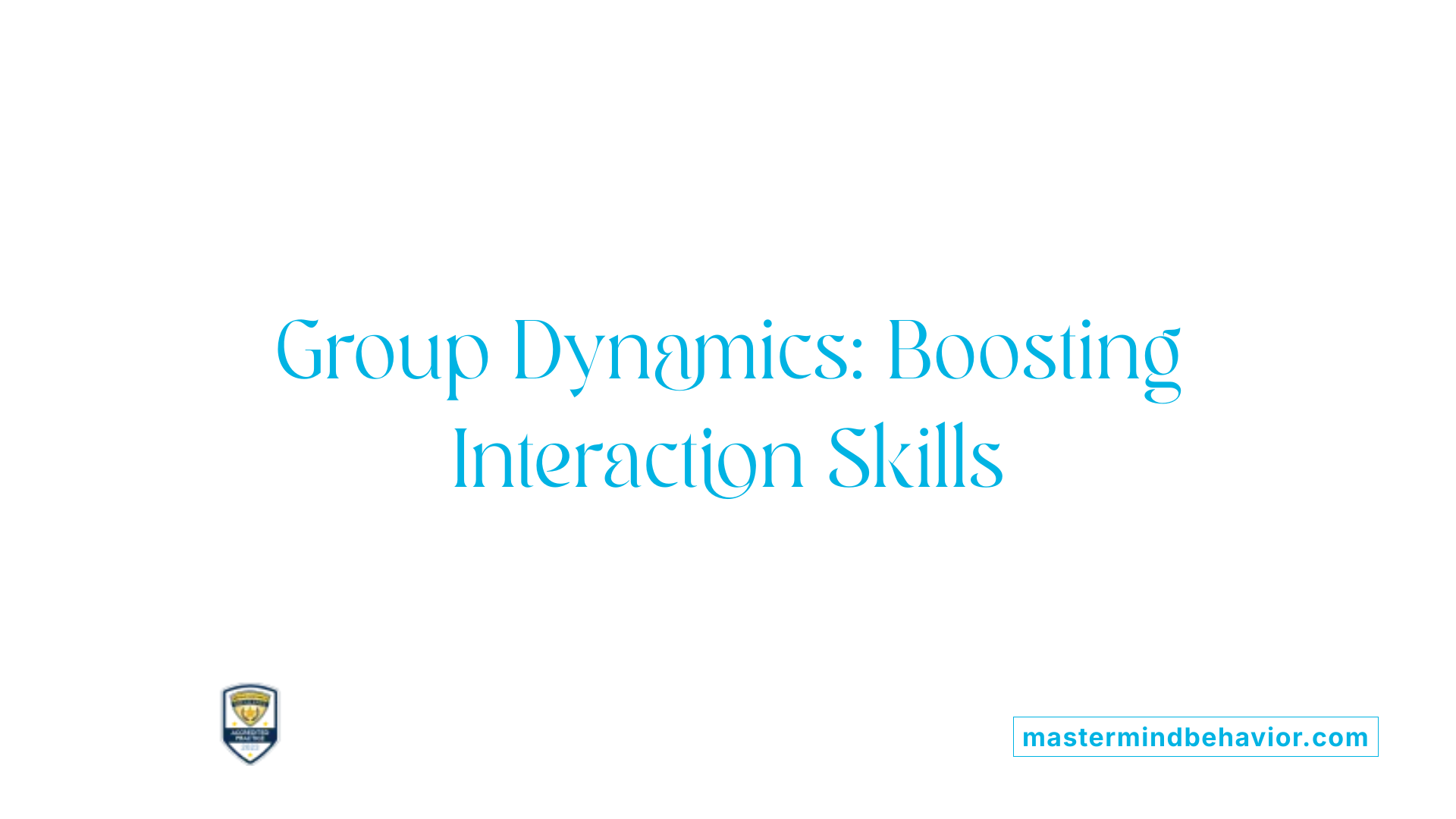
Format and structure of social skills groups
Social skills groups designed for children with autism typically involve small groups led by trained professionals, such as psychologists or speech therapists. These groups meet regularly, often weekly, providing a consistent, structured environment where children can learn and practice social play skills.
Peer modeling and role-playing activities
A central component of these groups is peer modeling, where children observe and imitate positive social behaviors demonstrated by peers or facilitators. Role-playing exercises further allow participants to practice communication and turn-taking in a safe, supportive setting.
Facilitating naturalistic social play
Groups encourage naturalistic social play by creating scenarios that mirror everyday interactions. Facilitators guide children through cooperative games and shared activities that require communication, problem-solving, and collaboration, promoting spontaneous social engagement.
Group dynamics and inclusion strategies
Effective groups foster inclusive environments that respect each child's unique abilities. Strategies such as pairing children with diverse skill sets and using visual supports help promote participation and reduce anxiety, ensuring all members can benefit from social learning experiences.
Enhancing Communication Through Play-Based ABA Strategies

Stimulating Language Development During Play
Play-based ABA interventions often create rich opportunities to foster language skills. Structured play scenarios encourage children with autism to engage with their environment and peers, naturally prompting speech and gesture use. Activities are designed to be motivating, helping children practice naming objects, describing actions, and responding to prompts in an enjoyable setting.
Using Prompts and Reinforcement for Speech and Gesture
In play sessions, therapists use prompts like modeling words or gestures to guide children toward verbal or non-verbal communication. When children attempt speech or gesture, positive reinforcement such as praise or tangible rewards strengthens these behaviors. This approach helps them associate communication efforts with positive outcomes, gradually increasing spontaneous use.
Encouraging Spontaneous Communication
Beyond prompted responses, interventions also focus on eliciting spontaneous communication. By creating engaging play contexts with interesting materials or peer interactions, children are motivated to initiate communication naturally. Techniques such as JASPER emphasize joint attention and shared play to encourage children to request, comment, or express emotions without direct instructions.
Linking Play Actions to Verbal Skills
Play actions are systematically connected to language development. For example, stacking blocks can be paired with labeling (“block,” “stack”), or role-play scenarios may involve practicing conversational turn-taking and vocabulary. This linkage makes language meaningful by embedding it within enjoyable and relevant activities, promoting generalization of skills beyond therapy.
Overall, play-based ABA strategies provide a dynamic framework where communication is integrated seamlessly into activities children find engaging, supporting growth in social and language skills through consistent, reinforced practice.
Incorporating Occupational Therapy Principles in ABA Play Interventions
How is sensory integration addressed during play?
Occupational therapy in ABA play interventions often includes sensory integration techniques to help children with autism process sensory information effectively. Activities are designed to provide controlled sensory experiences, such as tactile play, swinging, or use of textured toys. These help children manage sensory sensitivities and improve attention and participation during play sessions.
How does occupational therapy support fine and gross motor skill development?
Play activities guided by occupational therapists include tasks that promote both fine motor skills, like manipulating small objects or building blocks, and gross motor skills, such as jumping, balancing, or hand-eye coordination exercises. These motor skills are essential for enabling children to engage independently and confidently in various play settings.
What strategies support sensory needs to enable peer engagement?
Tailoring play interventions to individual sensory preferences ensures children are comfortable and less overwhelmed. Therapists might adapt environments—like dimming lights or reducing noise—or introduce sensory tools, such as fidget toys or weighted blankets. Such supports help children stay regulated and more attuned to social interactions with peers.
How does collaborative multidisciplinary planning enhance these interventions?
Occupational therapists collaborate closely with psychologists, speech therapists, educators, and behavior analysts to create comprehensive play-based intervention plans. This teamwork ensures that sensory, communication, motor, and social goals are integrated effectively, providing a holistic approach tailored to the child’s unique needs.
By embedding occupational therapy principles within ABA play interventions, practitioners enhance not only the social and communicative outcomes but also physical and sensory skills fundamental for meaningful play experiences.
Educators’ Role in Supporting ABA-Based Peer Play
Embedding ABA principles in classroom settings
Educators play a crucial role in applying Applied Behavior Analysis (ABA) principles during peer play to support children with autism. By integrating structured reinforcement and prompting techniques, teachers can encourage positive social interactions and communication among peers. These strategies help in shaping desired behaviors and reducing social barriers within classroom activities.
Fostering inclusive peer play opportunities
Creating an inclusive environment where all children feel welcomed during play is essential. Educators can facilitate play scenarios that promote interaction between children with autism and their typically developing peers. This inclusivity enhances social engagement and provides natural opportunities for learning social play skills.
Collaboration with therapists and families
Effective support for ABA-based peer play often involves collaboration between educators, therapists, and families. Regular communication ensures consistency in strategies and goals, allowing for shared progress monitoring. Therapists can provide guidance on specific intervention approaches such as JASPER or LEGO therapy, which educators can adapt within the classroom.
Adjusting environments to encourage socialization
Teachers can modify the physical and social classroom environment to facilitate social play. This includes organizing play areas with engaging materials that promote joint attention, offering structured play activities, and ensuring clear routines. Such adjustments make it easier for children with autism to participate actively and build communication skills during peer interactions.
Parent Training Programs Enhancing Play-Based ABA Outcomes
What is the scope and content of parent training?
Parent training programs in play-based ABA (Applied Behavior Analysis) interventions equip caregivers with skills to foster their child's social and communication development through play. These programs cover strategies to create supportive play environments, identify opportunities for peer interaction, and use play as a natural context for learning.
What techniques help continue ABA strategies at home?
Parents learn to implement ABA techniques like prompting, reinforcement, and modeling during everyday play activities. Training often includes coaching on how to initiate joint attention, respond to communicative attempts, and gradually shape more complex play behaviors that align with goals set by therapists.
How can parents encourage peer play?
Programs guide caregivers on facilitating positive play interactions between their child and peers. This might involve organizing structured group play, teaching turn-taking, sharing, and social problem-solving skills, and using familiar play materials to reduce anxiety.
How do these programs build caregiver confidence and skills?
By providing hands-on practice, feedback, and troubleshooting during parent sessions, these trainings empower caregivers to become active partners in intervention. This involvement enhances consistency in applying ABA principles, leading to better developmental outcomes for children.
Together, parent training is essential in reinforcing play-based ABA progress outside clinical settings and nurturing social engagement in everyday contexts.
Sustaining Peer Engagement: Strategies for Long-Term Success

How Can Gains Be Maintained Beyond Therapy Sessions?
Maintaining progress after formal play-based interventions is crucial. Strategies include involving caregivers and educators to reinforce skills consistently. Parent training programs equip families with tools to support ongoing social play and communication at home. Encouraging daily practice outside therapy sessions helps solidify learning and prevent skill regression.
How Can Skills Be Generalized to Multiple Settings?
Generalizing learned behaviors requires introducing play interactions in varied environments. This might involve transitioning from therapy rooms to playgrounds, classrooms, or community centers. Multidisciplinary teams tailor interventions to include natural contexts, promoting flexibility and adaptability in social skills.
How Is Self-Initiated Play Encouraged?
Fostering self-initiated play interactions empowers children to engage peers spontaneously. Approaches such as LEGO therapy and joint attention techniques like JASPER encourage children to take the lead, enhancing motivation and peer engagement. Positive feedback and reinforcement support developing independence in social play.
Why Monitor and Adjust Plans Over Time?
Children's needs evolve, making ongoing assessment and plan modification essential. Regular monitoring through outcome measures focusing on social and communication skills allows professionals to adapt goals and strategies. Collaboration among psychologists, speech therapists, occupational therapists, and educators ensures interventions remain effective and responsive.
| Strategy | Description | Professionals Involved |
|---|---|---|
| Caregiver Involvement | Training parents to support skills at home | Educators, Speech Therapists |
| Setting Variation | Practicing skills in multiple environments | Psychologists, Occupational Therapists |
| Self-Initiated Play Encouragement | Using approaches like JASPER and LEGO therapy | Behavioural Therapists, Special Educators |
| Continuous Monitoring | Regular assessment and plan adjustments | Multidisciplinary Team |
The Role of Motivation in Play-Based ABA Therapy
Identifying Motivators in Social Play
Understanding what motivates a child during social play is crucial in play-based ABA therapy. Children's preferences, interests, and responses during play sessions can reveal effective motivators that encourage engagement and communication. Therapists often observe which toys, themes, or types of interactions spark enthusiasm.
Incorporating Interests into Therapy
Incorporating a child's natural interests into therapy activities enhances motivation. Using favored toys or themes not only captures attention but also creates a meaningful context for practicing social and communication skills. For example, if a child enjoys building blocks, integrating LEGO therapy can promote joint attention and interaction.
Use of Reinforcement Schedules to Maintain Motivation
Effective reinforcement schedules are applied to sustain motivation during therapy. Consistent and predictable rewards following desired behaviors help children associate social play with positive outcomes. Therapists may use immediate praise, access to preferred activities, or tangible rewards aligned with individual interests to reinforce progress.
Strategies to Overcome Play Aversion
Some children with autism might initially display aversion to play due to sensory sensitivities or previous negative experiences. Therapists employ gradual exposure, modeling, and adaptive techniques tailored to each child’s needs to gently encourage participation. Parent training programs further support these strategies by empowering caregivers to reinforce play engagement at home.
Through these approaches, motivation is carefully nurtured within play-based ABA interventions to promote social interaction, communication development, and overall positive engagement.
Addressing Sensory Needs Within Play to Enhance Engagement
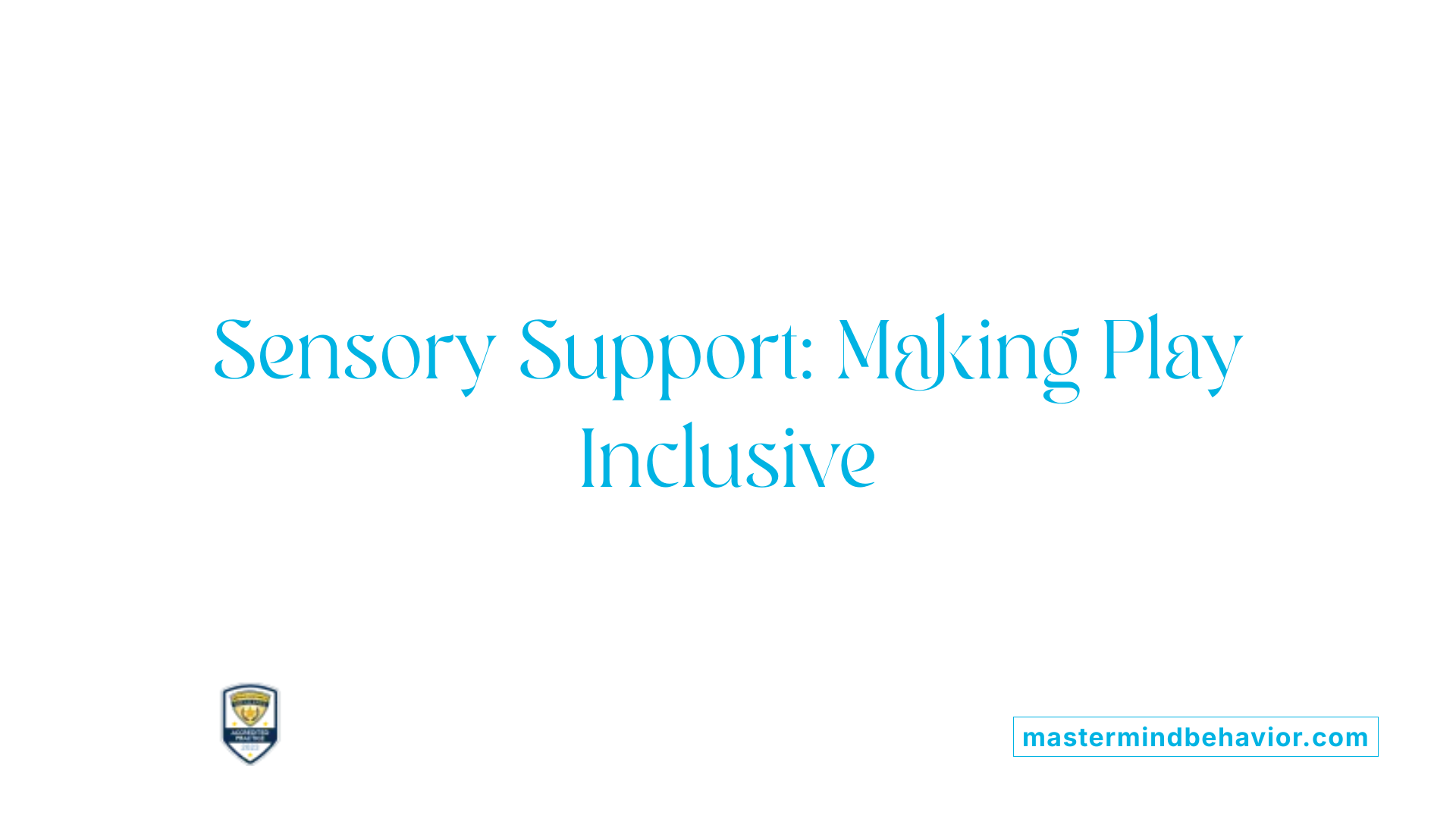
What are common sensory challenges in autism?
Children with autism often experience heightened or reduced sensitivity to sensory input. These can include overreacting to loud noises, bright lights, or certain textures, as well as seeking additional sensory stimulation through movements or touch. Such sensory processing differences can impact their ability to engage comfortably in play activities.
How can play activities be modified to accommodate sensory sensitivities?
Modifications in play can create a more inclusive and comfortable environment. This might involve adjusting the lighting to be softer, reducing background noise, or allowing children to choose the type and intensity of sensory experiences. Structured routines and predictable play sequences also help children feel secure and engaged.
What is the role of sensory-friendly toys and environments?
Sensory-friendly toys that provide calming or controlled stimulation—such as soft textures, weighted objects, or visual aids—support children with sensory sensitivities by encouraging interaction without overwhelming them. Creating an environment with quiet zones, gentle textures, and minimal distractions allows children to focus better and participate more fully in social play.
How does addressing sensory needs impact peer interaction and focus?
When sensory needs are met, children with autism are more likely to remain engaged and attentive during play, enhancing opportunities for social interaction and communication. By reducing sensory overload, these adaptations encourage positive peer interactions, improve focus, and contribute to the development of social and communication skills central to many play-based interventions.
Naturalistic Developmental Behavioral Interventions in Play ABA
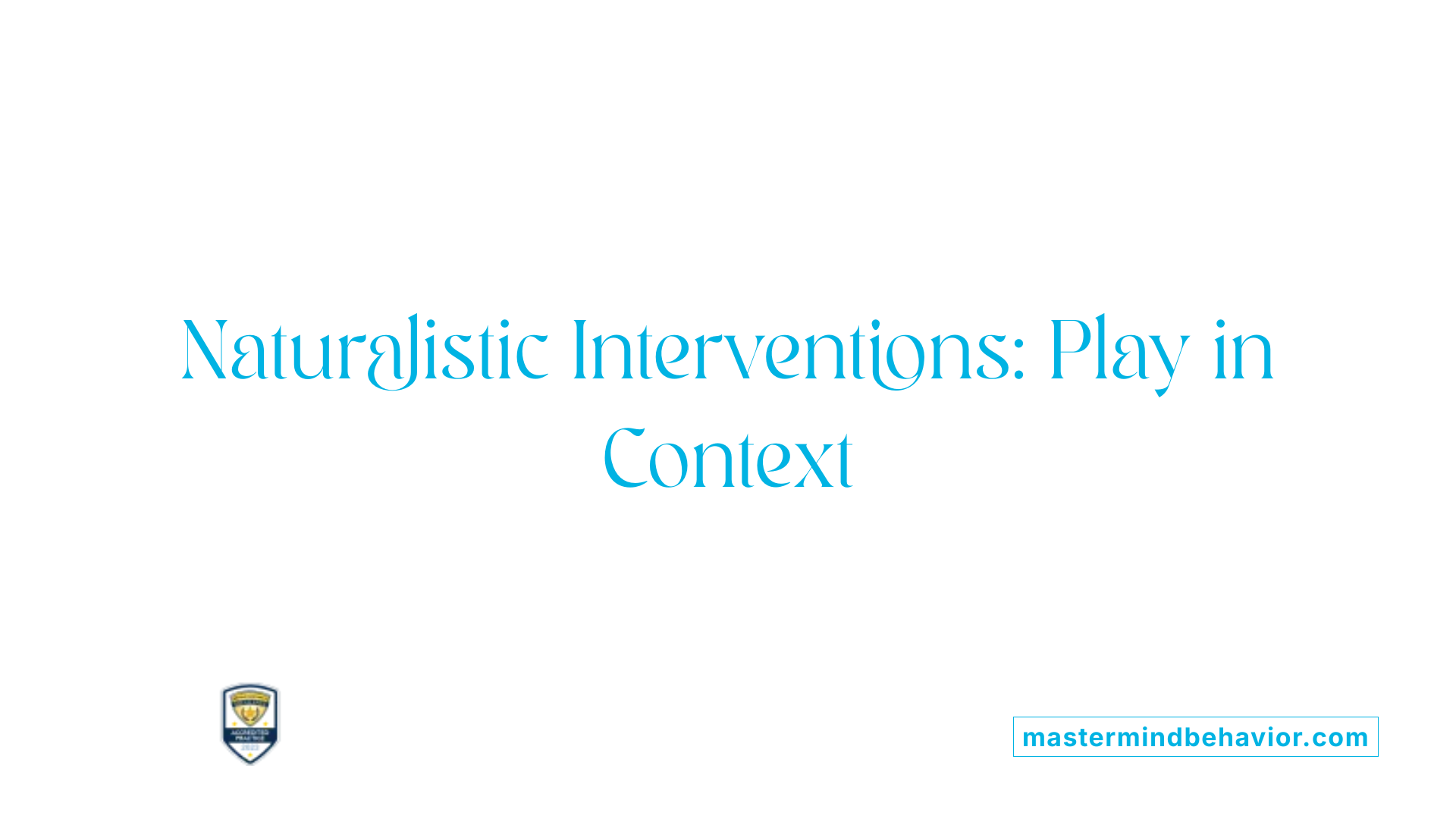
What Are Naturalistic Developmental Behavioral Interventions?
Naturalistic Developmental Behavioral Interventions (NDBI) blend behavioral techniques with developmental science to support children with autism in engaging naturally with their environment. These interventions take place within everyday play settings, making learning meaningful and enjoyable.
How Does Child-Led Play Feature in These Interventions?
Central to NDBI is facilitating child-led play, where the child's interests and actions guide the interaction. This approach encourages spontaneous communication and social engagement, fostering intrinsic motivation rather than structured demands.
How Are Behavioral Supports Combined with Developmental Goals?
NDBI integrates behavioral strategies such as prompting, reinforcement, and feedback with developmental objectives, like joint attention and language skills. This combination helps children progress in social communication while participating in enjoyable play activities.
What Are Examples of Naturalistic ABA Approaches?
Examples include the JASPER (Joint Attention, Symbolic Play, Engagement, and Regulation) model, which targets social communication within play-based contexts. Other approaches use strategies like LEGO therapy or robot-assisted play to encourage interaction and communication in developmentally appropriate ways.
These methods demonstrate how naturalistic interventions align behavioral principles with developmental goals, using play as both the context and the catalyst for growth.
Leveraging Peer Modeling to Improve Social Play
Theory behind peer modeling
Peer modeling relies on the concept that children with autism can learn social behaviors by observing and imitating their neurotypical peers. This approach utilizes naturalistic play settings where these children witness positive social interactions and communication skills demonstrated by peers who exhibit typical development patterns.
Role of neurotypical peers in therapy
Neurotypical peers serve as live examples during therapy, providing spontaneous and authentic scenarios for social play. Their natural responses and interactions help children with autism better understand social cues, turn-taking, and collaborative play dynamics, making learning both engaging and contextually relevant.
Techniques for encouraging peer-led interactions
Intervention programs encourage peer-led interactions by structuring play activities that naturally draw children together, such as group games or shared building tasks like LEGO therapy. Facilitators may subtly guide peers to initiate or sustain interactions without overtly leading, promoting genuine peer engagement. Strategies also include training neurotypical peers to model targeted social behaviors and reinforce positive communication.
Outcomes linked to peer influence
Research consistently links peer modeling with improvements in social communication, joint attention, and enhanced social play skills in children with autism. These positive outcomes are often measured by increased duration and quality of interactions, greater use of language, and successful participation in group activities, highlighting the efficacy of peer-led approaches within multidisciplinary interventions.
Utilizing Prompting Techniques to Support Social Play
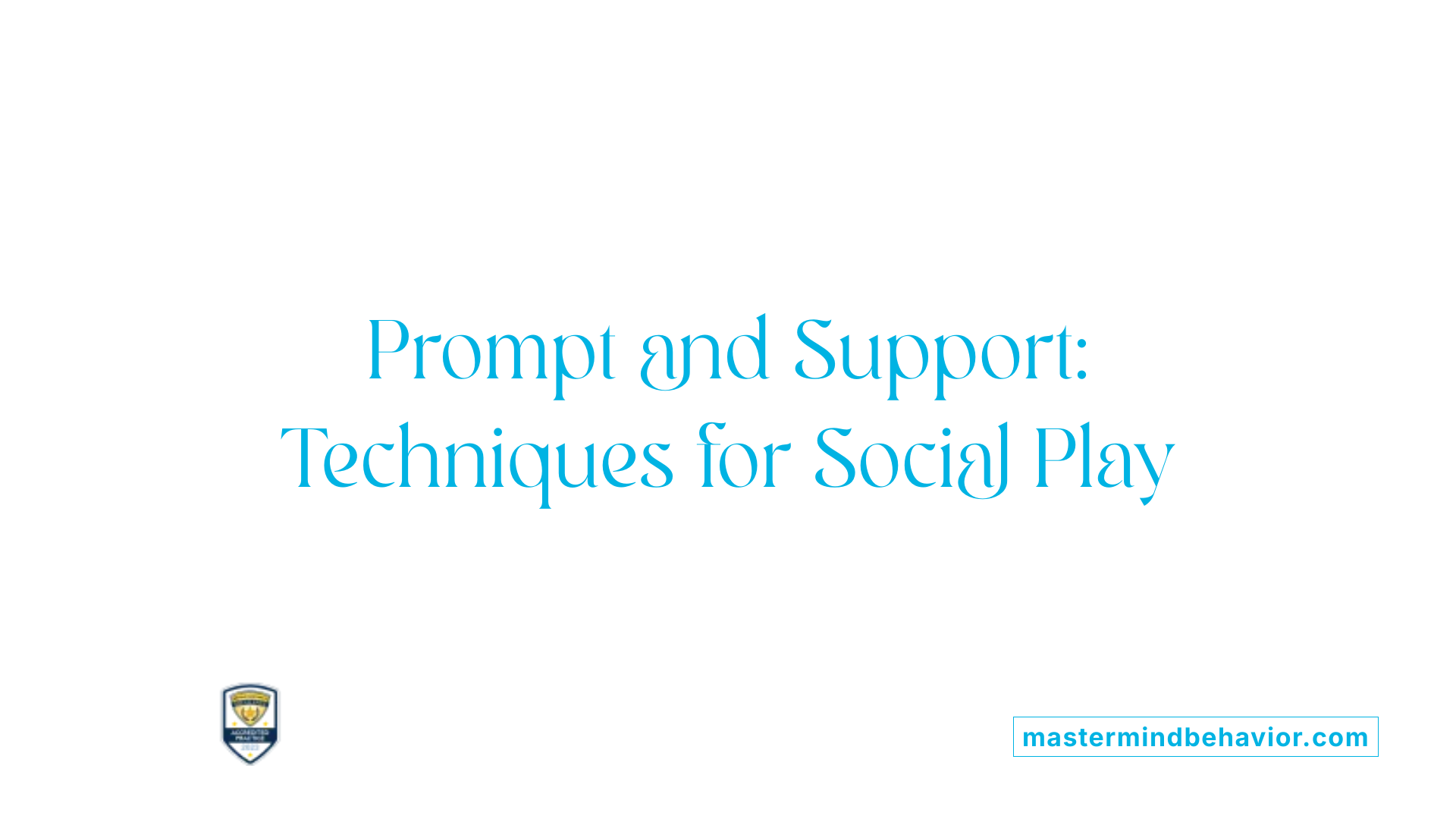
What Types of Prompts Are Used in ABA Play Therapy?
In Applied Behavior Analysis (ABA) play therapy, various types of prompts are employed to facilitate social play skills in children with autism. Common prompts include verbal cues, modeling actions, physical guidance, and visual aids. These prompts help children initiate and maintain interactions, supporting communication development during play.
How Are Prompts Faded to Encourage Independence?
Prompt fading is a crucial strategy to promote independence. Therapists gradually reduce the level or frequency of prompts so the child can perform social play behaviors autonomously. For example, moving from physical prompting to verbal cues and eventually to no prompting helps reinforce learned skills without dependence on adult assistance.
When Are Prompts Most Effective, Considering Timing and Appropriateness?
Timing and appropriateness of prompts are essential for success. Prompts should be given immediately or just before the desired behavior to increase the likelihood of correct responses. Additionally, choosing the right type of prompt based on the child's maturity and needs ensures effective learning without causing frustration or overreliance.
How Do Prompts Support Initiating and Maintaining Play?
Prompts assist both in initiating play interactions—such as inviting a peer to join—and in maintaining ongoing play activities through reminders or encouragement. This helps children practice social engagement and communication skills, critical areas often targeted in early intervention programs.
Overall, prompting techniques in ABA play therapy are thoughtfully tailored and gradually adapted, supporting meaningful social play development for young children with autism.
Incorporating Reinforcement Strategies During Play

How Are Positive Reinforcement Methods Used in Play-Based Interventions?
Positive reinforcement is a cornerstone in play-based interventions for children with autism. It involves providing a desirable response immediately following a target behavior to increase its future occurrence. During play, professionals and parents use positive reinforcement to encourage social interaction, communication attempts, and engagement.
How Do You Select Meaningful Reinforcers?
Selecting the right reinforcers depends on the child's preferences and motivations. Meaningful reinforcers can be social in nature, such as praise or attention, or tangible, like favorite toys or snacks. Tailoring these to the child's preferences ensures that the reinforcement effectively supports learning within the playful context.
What Are Common Types of Reinforcement Used?
- Praise: Verbal affirmations like "Great job!" help reinforce social and communicative behaviors.
- Tangible Rewards: Access to preferred items or activities after accomplishing a play goal.
- Social Reinforcement: Positive interactions such as high-fives, smiles, or shared enjoyment during play.
Why Is Timing of Reinforcement Delivery Important?
The reinforcement must closely follow the desired behavior during play to make the connection clear. Immediate reinforcement helps the child associate their action with the positive outcome, increasing the likelihood of repeating the behavior and facilitating social and communication skill development.
Role of Communication Facilitators in Play ABA Therapy
Speech Therapists' Integration in ABA Play Therapy
Speech therapists play a vital role in play-based Applied Behavior Analysis (ABA) therapy for children with autism. They work closely with behavior analysts to enhance language and communication skills during play activities. Their integration helps tailor interventions to the child's unique speech and language needs, making communication a natural part of play sessions.
Use of Augmentative and Alternative Communication (AAC) Devices
AAC devices are commonly incorporated into play ABA therapy to support children who are nonverbal or have limited speech. These tools, ranging from picture exchange systems to high-tech speech-generating devices, enable children to express needs and engage socially during play, thus fostering communication development within a familiar, motivating context.
Supporting Nonverbal Communication in Play
For children struggling with verbal communication, therapists emphasize nonverbal cues such as gestures, eye contact, and body language during play. This focus helps build foundational social interaction skills that are essential for later verbal communication, ensuring that play remains an accessible and effective platform for communication development.
Collaboration with Behavior Analysts
Communication facilitators collaborate closely with behavior analysts to design and implement interdisciplinary play-based interventions. This teamwork ensures that communication goals align with behavioral objectives, maximizing the effectiveness of therapy. The multidisciplinary approach also allows for continuous feedback and adjustment of strategies to best support each child's social and communication growth.
Evaluating Social Play Development Over Therapy Course
How is progress tracked in social play milestones?
Tracking progress in social play involves regular assessments that focus on key behaviors such as initiating and responding in play, sharing enjoyment, and taking turns. Therapists often use structured observation tools and checklists during sessions to monitor children's engagement and skill advancement. These assessments provide measurable indicators of improvement in social interaction and communication abilities.
How do baseline and ongoing assessments compare?
Baseline assessments establish a starting point by identifying each child's current social play abilities, including strengths and challenges. Subsequent ongoing assessments allow therapists to observe changes over time, comparing progress to the baseline. This comparison helps determine the effectiveness of the intervention and highlights specific areas where the child is advancing or may require additional support.
What barriers and facilitators affect social play development?
Several factors can either hinder or support progress in social play. Barriers often include limited communication skills, sensory sensitivities, or difficulties with attention and motivation. Facilitators encompass supportive family involvement, the use of engaging play materials like LEGO or robots, and collaborative efforts among multidisciplinary team members, such as speech therapists and educators.
How is intervention intensity adjusted according to progress?
Based on regular evaluations, intervention intensity can be modified to better suit the child's evolving needs. If progress is slow, therapists might increase session frequency or introduce more targeted strategies like joint attention techniques (e.g., JASPER). Conversely, when substantial gains are evident, the intervention may shift to focus on generalizing skills to new settings or promoting independence in social play.
| Aspect | Description | Example |
|---|---|---|
| Progress Tracking | Regular observations and structured assessments | Using checklists to monitor turn-taking and shared enjoyment |
| Baseline vs Ongoing Assessments | Comparing initial skills to ongoing improvements | Noting increased frequency of initiated interactions over time |
| Barriers and Facilitators | Factors impacting progress positively or negatively | Sensory sensitivities (barrier), parent involvement (facilitator) |
| Intervention Adjustment | Modifying session frequency or techniques based on progress | Increasing JASPER sessions if joint attention gains are slow |
Future Directions in ABA Therapy for Autism Play Interventions
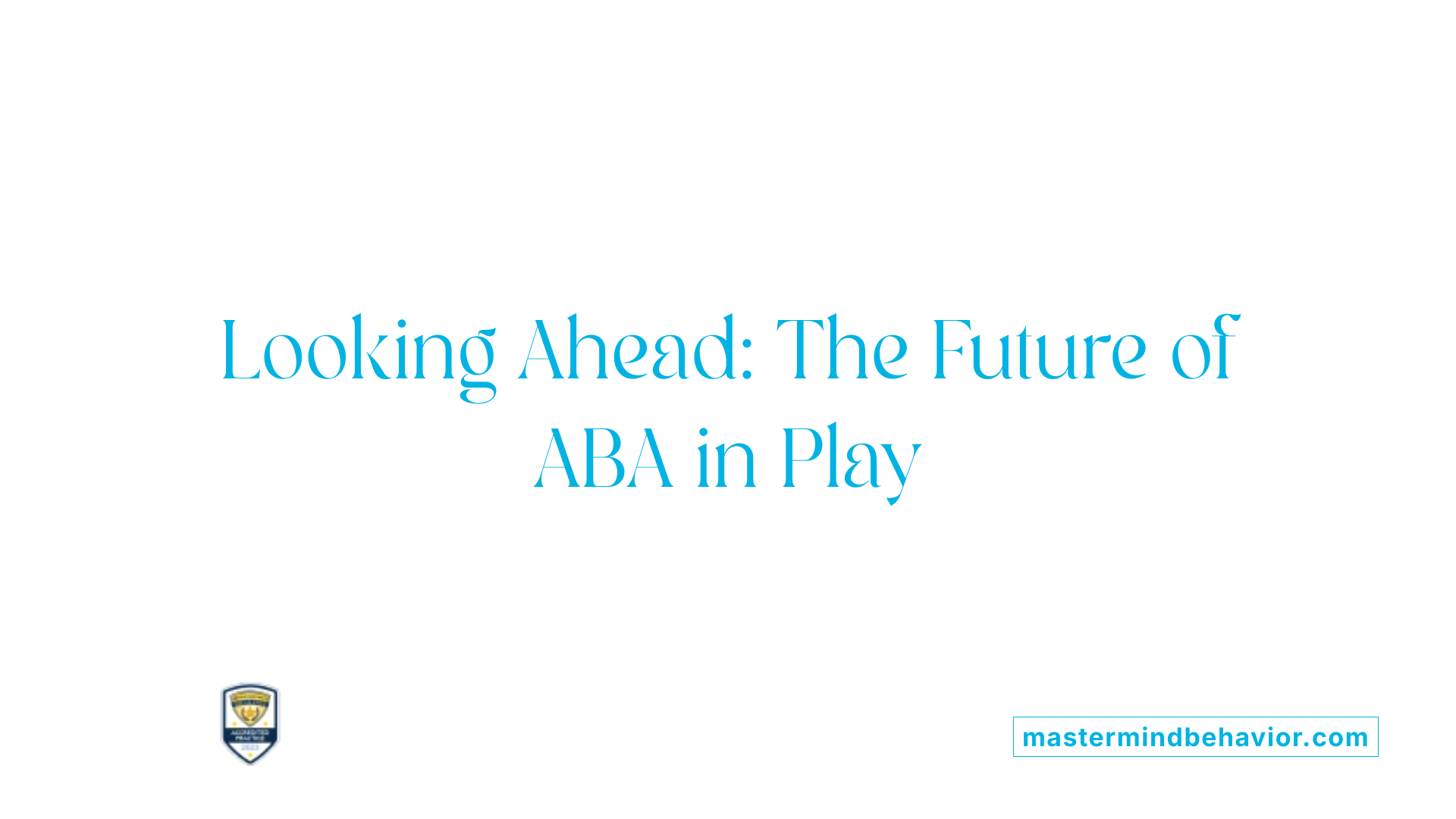
What are the emerging research trends in ABA play interventions for autism?
Recent research highlights a shift toward diversified approaches within play-based interventions. Studies increasingly combine behavioral, developmental, and interdisciplinary methods to tailor interventions precisely to individual needs. Moreover, there is a growing emphasis on robust study designs, including randomized controlled trials, to strengthen evidence for play as a vehicle for social and communication skill development.
How is technology integrated into these innovative methods?
Technology is becoming a significant tool in advancing play-based interventions. Robot-assisted play, for example, offers interactive and engaging ways for children to learn social skills. Such technologies provide consistent, repeatable social interaction scenarios that help children practice communication in a controlled environment. Additionally, digital platforms are facilitating parent training and monitoring of progress, enhancing accessibility and consistency of intervention strategies.
Why focus on peer-mediated interventions?
Peer-mediated interventions involve typically developing peers in therapy sessions to promote naturalistic social interaction. This approach encourages the generalization of social skills by fostering authentic play and communication opportunities, moving beyond adult-led activities to more spontaneous peer engagement. It also supports inclusion, helping children with autism develop friendships and social understanding in real-world settings.
What strategies enhance generalization and maintenance of learned skills?
To ensure skills learned during play interventions persist, strategies like embedding learning into everyday activities and environments are pivotal. Multidisciplinary teams—including psychologists, speech therapists, and educators—work collaboratively to reinforce skills across contexts. Programs often incorporate parent and caregiver training to support continuation at home, aiding maintenance and wider application of social and communication abilities.
| Aspect | Description | Implications for Practice |
|---|---|---|
| Research Trends | Diversified, robust methodological approaches | Tailored, evidence-based interventions |
| Technology Integration | Robot-assisted, digital training platforms | Enhanced engagement and accessibility |
| Peer-Mediated Interventions | Inclusive, naturalistic play scenarios | Promotes real-world social skill generalization |
| Generalization Strategies | Multidisciplinary collaboration, caregiver involvement | Sustained skill maintenance across environments |
Advancing Peer Engagement in Autism Through Play-Based ABA Therapy
ABA therapy, implemented within the natural context of play, offers a powerful avenue for enhancing peer engagement and social communication among children with autism. Harnessing a multidisciplinary approach, individualized strategies, and evidence-based techniques, these interventions focus on early engagement and sustained skill development. Ongoing research continues to optimize methods and incorporate innovative tools, underscoring the importance of tailored, play-based ABA programs in fostering meaningful social connections and improving quality of life for individuals on the autism spectrum.
References
- Play-based interventions to support social and ...
- The effectiveness of applied behavior analysis program ...
- Applied Behavior Analysis (ABA)
- How to Measure ABA Therapy's Effectiveness
- How Effective Is ABA Therapy? Success Rates Explained
- Applied Behavior Analysis (ABA)
- Applied Behavior Analysis (ABA)
Recent articles

How ABA Therapy Encourages Social Communication In Teenagers
Unlocking Social Skills Through Applied Behavior Analysis in Adolescents with Autism

Working Through Frustration: Helping Caregivers Manage Stress During ABA Therapy
Navigating Stress: Supporting Caregivers in the Journey of ABA Therapy

ABA Therapy To Support Conflict Resolution In Children
Harnessing ABA Techniques to Enhance Conflict Resolution Skills in Children

How ABA Therapy Reduces Avoidance Of Group Presentations
Empowering Communication and Social Engagement Through ABA Therapy
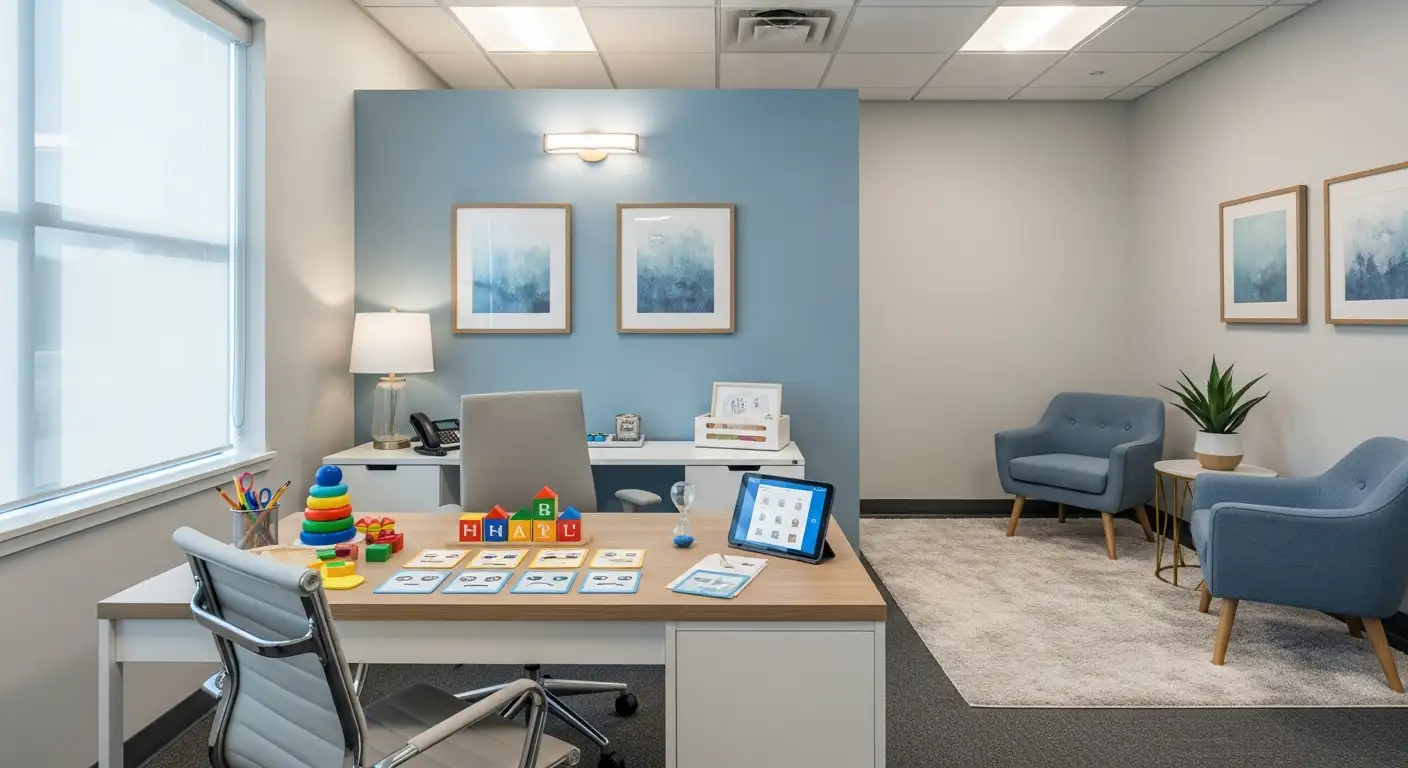
Addressing Sleep Challenges Through Behavior-Based Strategies In ABA
Harnessing ABA to Improve Sleep in Children with Autism
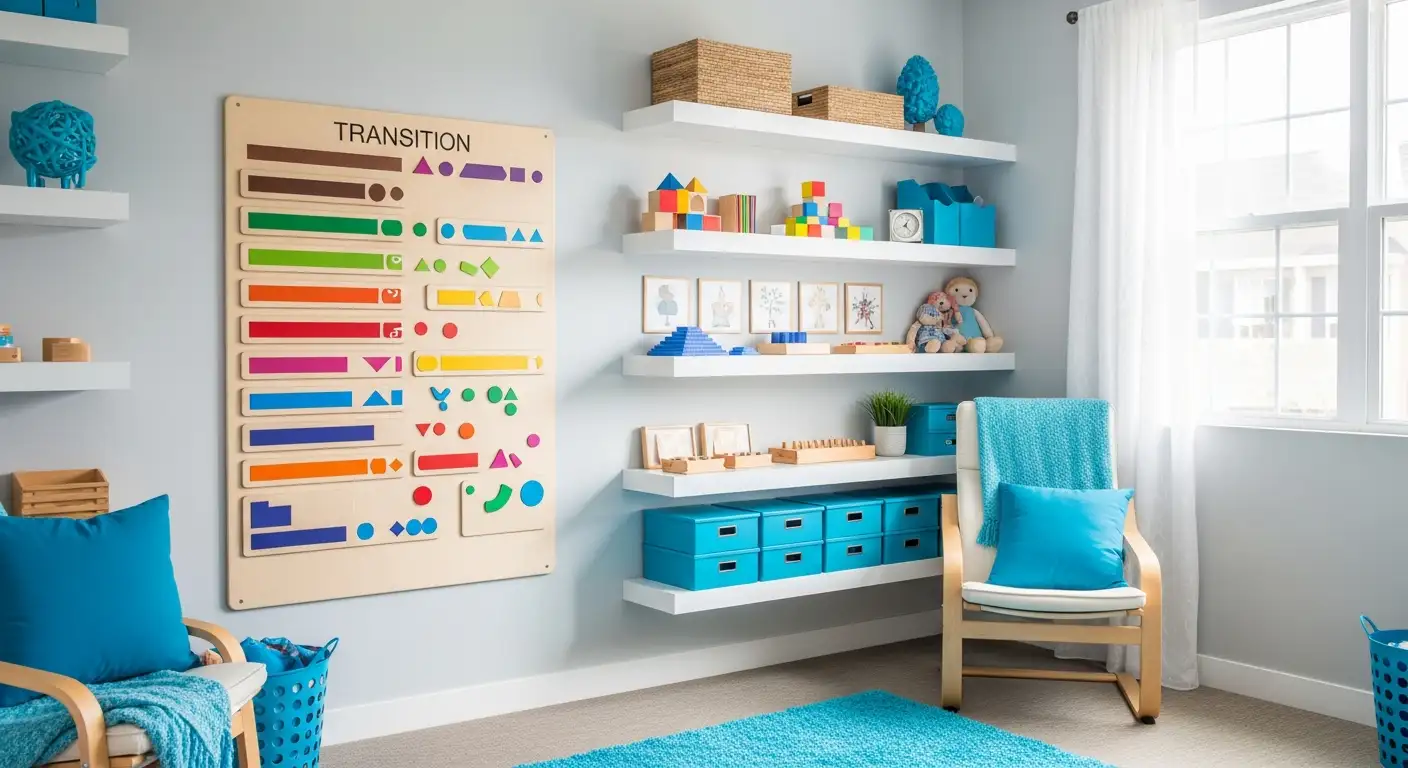
How ABA Therapy Improves Transitioning Between Activities
Mastering Day-to-Day Changes: The Role of ABA Therapy in Smooth Transitions for Children with Autism



